One of the best ways to explore a city is on foot. And while the big attractions are always the first place people go, the backstreets and hidden alleys are still worth visiting. In Kyoto, exploring the backstreets is as peaceful as it is insightful. This alternative walking tour of Kyoto focuses on exploring unknown places, which will reveal the city’s secrets. This is the best tour of Kyoto after you’ve already seen the must-see sights.
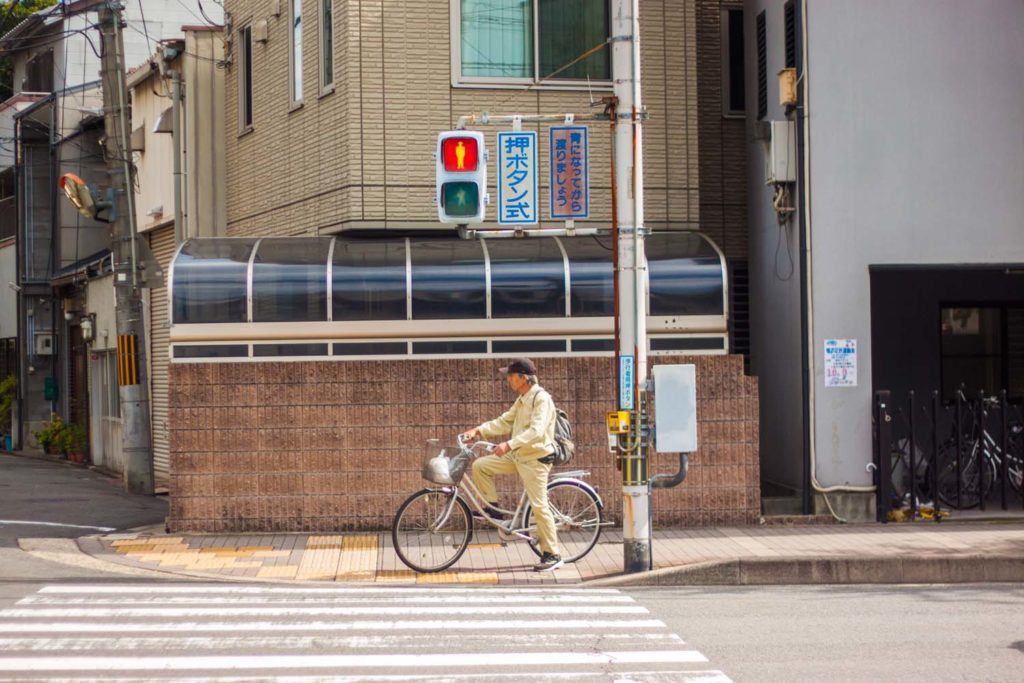
- Map of Walking Tour
- History of Kyoto
- Higashi Honganji Temple
- The Founder’s Hall Gate
- Kyosendo
- Tofu Shop
- Ayako Tenmangu Shrine
- Walden Woods Kyoto
- Fabric Stores
- Ichihime Jinja
- Ame-no-Mana-I Well
- Gojo Rakuen
- Takase River
- Artists Studios
- Yamauchi Nintendo
- Shomem-bashi Bridge
- Kanshundo Higashimisea
- Toyokuni Shrine
- Hoko-ji Temple
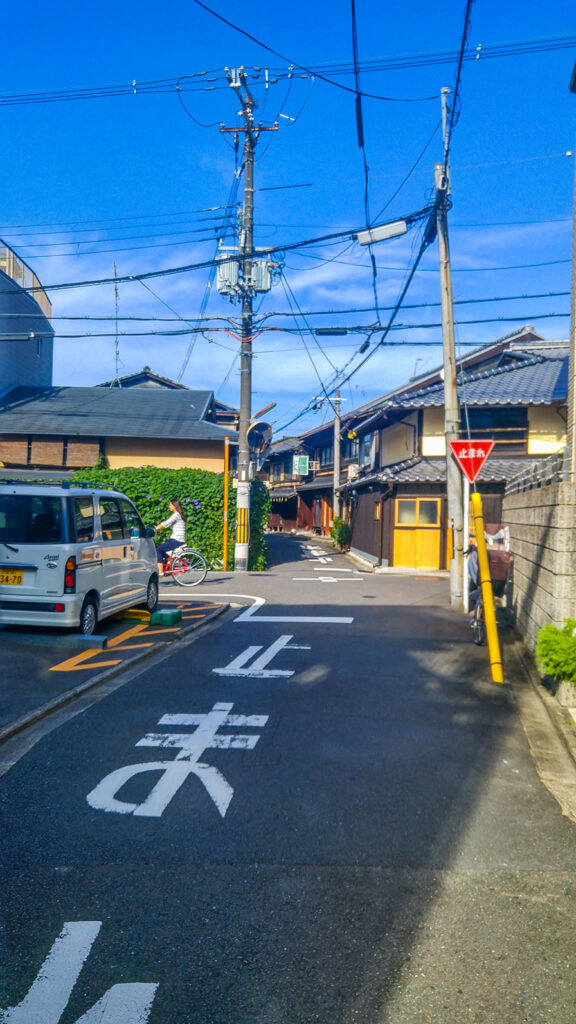
Map of Walking Tour
History of Kyoto
Although Kyoto is a modern city with 2.5 million inhabitants, it has a quiet, traditional side. Kyoto has evidence of settlements as early as the 6th century. But during the 8th century, Buddhists travelled to Kyoto from China to establish a new village that would become Kyoto.
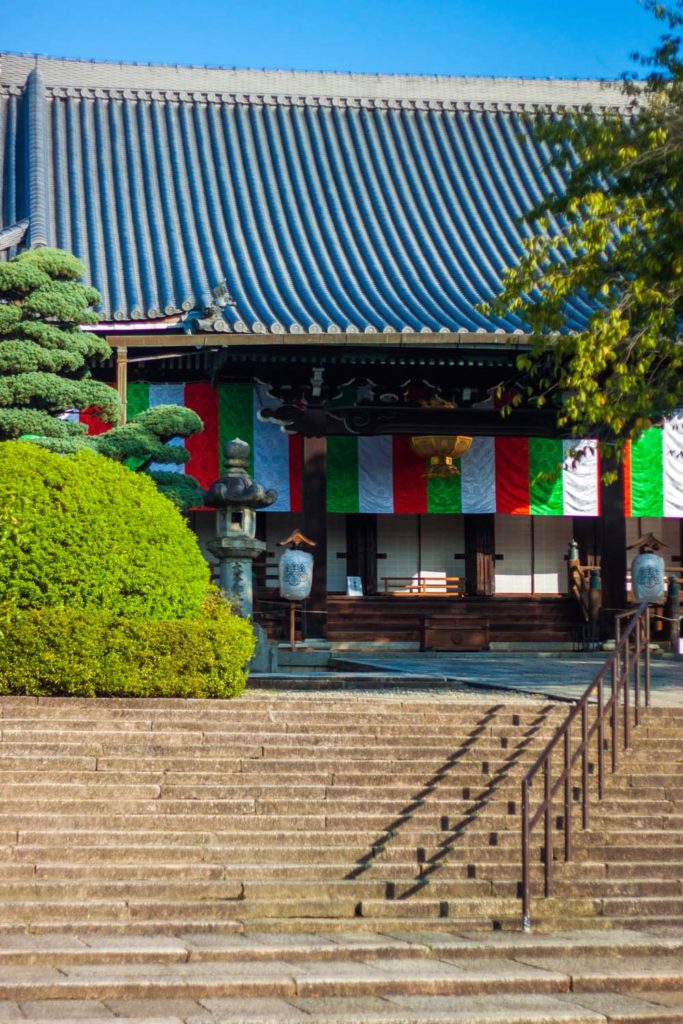
In the 16th century, Toyotomi Hideyoshi designed urban Kyoto using rectangular and square blocks of houses. Everything was designed to be accessible and easy to navigate, much like the grid structure New York is modelled on today.
The Divison of Kyoto
The city of Kyoto, once the capital of Japan, was established in a precise location for a particular reason. The Buddhists of the period said that a city should only be built in a place where four gods can protect it. There needed to be a mountain to the North, a river to the east, a road to the west, and a plain with water to the south.
Kami of Kyoto
Each one of those elements represented a different Kami (Japanese god). The Tortoise god was represented by the North Mountains Hiei and Atago. The West Road represented the White Tiger God, which connected Japan to all the major cities to the west. The Red Phoenix god was characterized by the Uji River and the south plains. And finally, the great Dragon God was represented by the eastern Kamo River. These elements made Kyoto the perfect spot, as per Chinese legends.
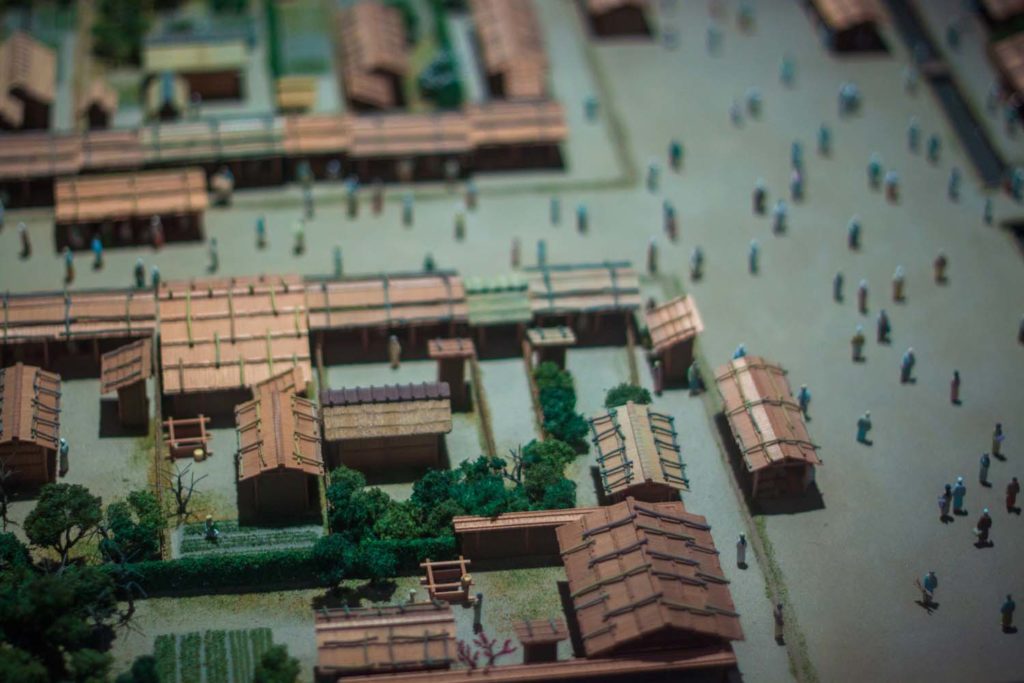
Because Kyoto was saved from the extensive bombings by the USA in WWII, the town has preserved much of its original architecture. Walking along these backstreets, there are ordinary residential houses that feel like museum pieces. A piece of history from another time and place. And yet they are just as ubiquitous as anything else on the street.
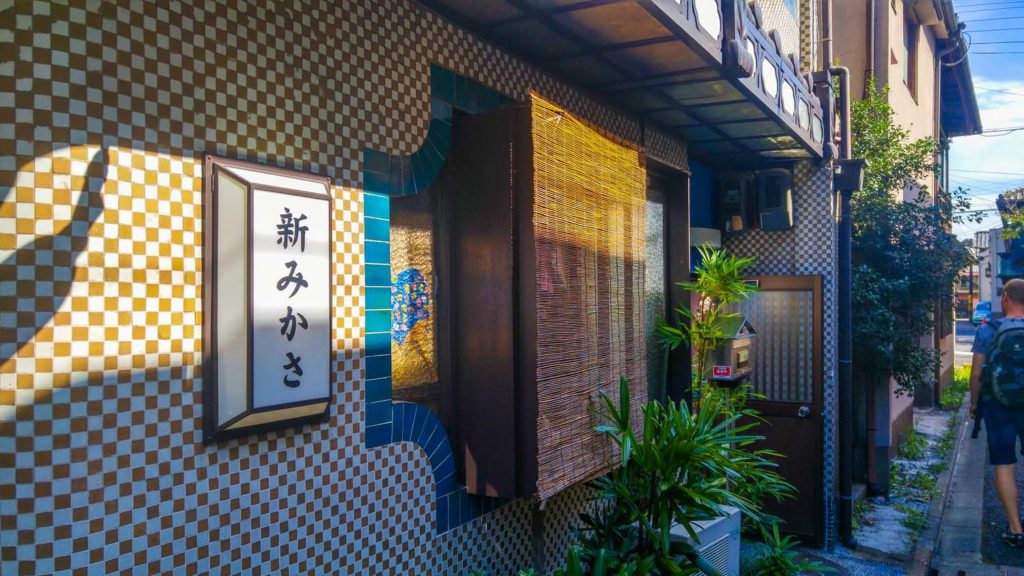
Higashi Honganji Temple
Our tour begins at the Higashi Honganji Temple. The temple complex is enormous as Higashi Honganji is one of Japan’s most prominent Buddhist denominations, and this is its headquarters. Higashi Honganji has approximately 10,000 local temples, 50 regional offices and over 200 temples overseas.
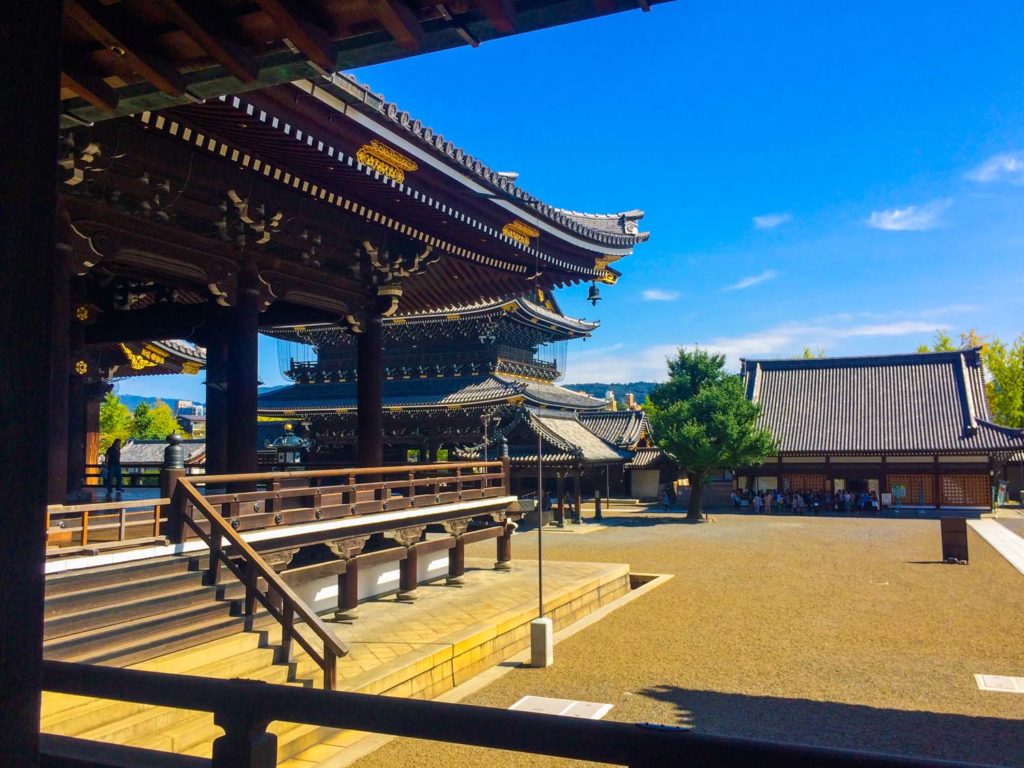
Goeido and Amidado Halls
The two buildings standing in the centre of the grounds are the Goeido Hall (dedicated to Shinran, the sect’s founder) and the Amidado Hall (dedicated to the Amida Buddha, the most important Buddha in Jodo-Shin Buddhism). These buildings are of great historical importance and have been designated as UNESCO world heritage sites. We begin here because these incredible structures were the blueprint onto which even the most modest house, garden or shrine was built to emulate. You’ll see details from the temples here everywhere you look, in small bits and pieces as we go!
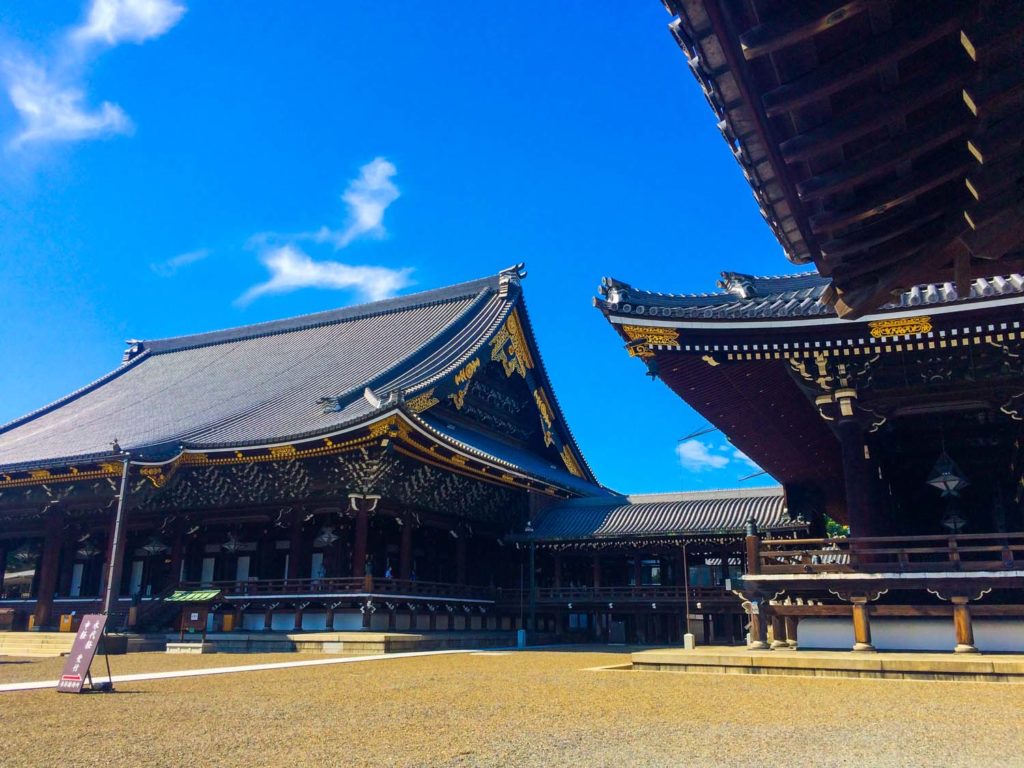
Cleansing Yourself Before Entering
Before entering the shrine, it is customary that you wash your hands. Washing is a means of cleansing the body before stepping onto the sacred ground. At the entrance to the temple, with a fierce dragon spewing water. Beneath him is a series of ladles. Take a spoon and, with water, pour it over one hand and the other. Finally, fill the scoop with water and pour it into your cupped hands. Rinse your mouth and spit the water beside the fountain (NOT INTO IT). Many visitors skip the mouth rinsing part, so if you’re not up for that, just be sure to cleanse your hands. Even if you are not religious, doing this is seen as a sign of respect in your visit to the temple.
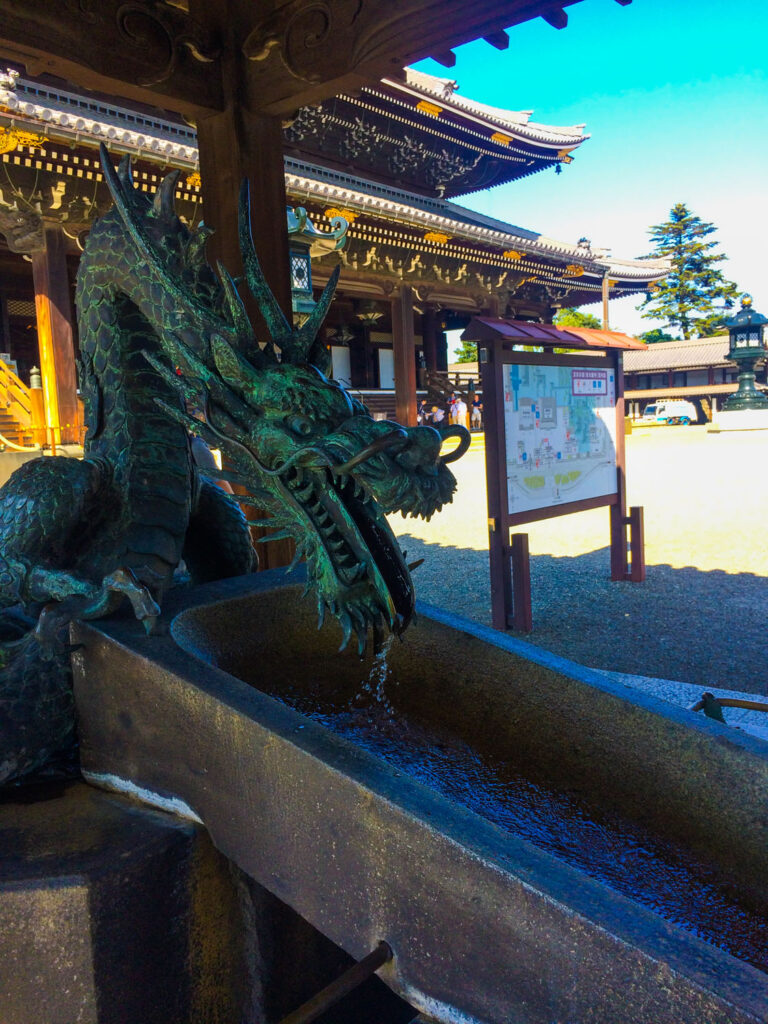
Shin Buddism
Jōdo Shinshū, or Shin Buddhism, started in 1173. It is the most popular form of Buddhism practised in Japan, partly due to its simple methods. Shin Buddhism “focuses on daily practice, open-minded reflection, and the direct and personal religious experience of the transcending mystery of life, symbolized by Amida Buddha.“

Goeido Hall
The Goeido Hall is one of Japan’s largest wooden structures. Originally built in the Edo period (1603–1868), the current structure is a faithful reconstruction of the Meiji period (1868–1912).
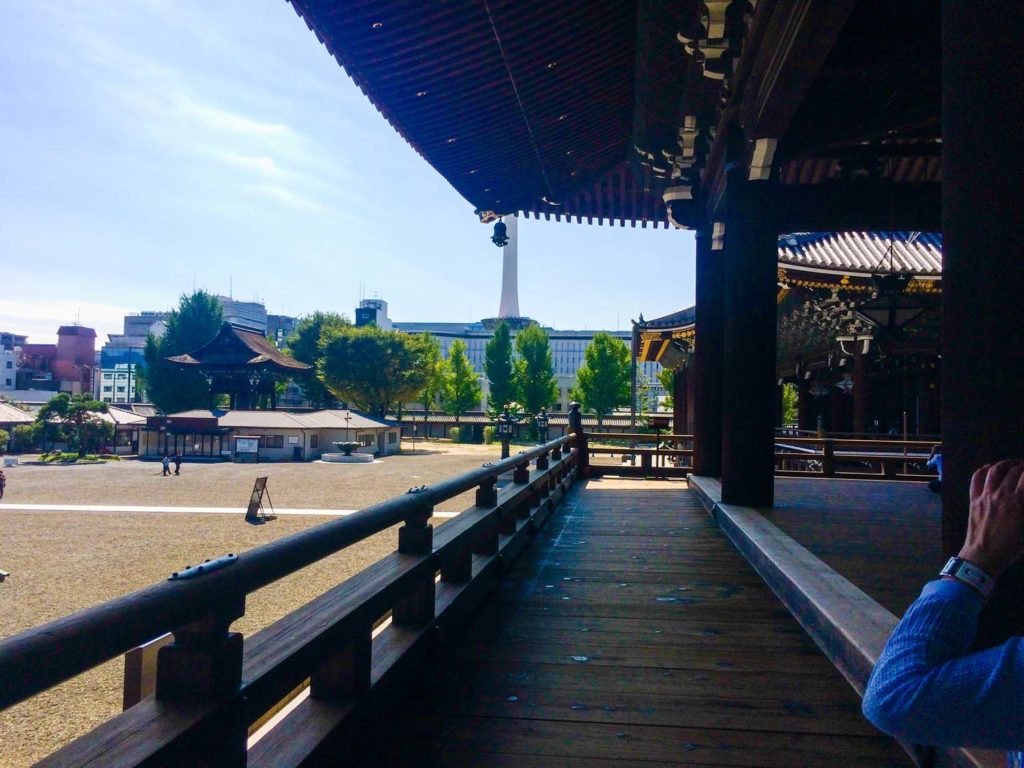
Inside the main hall, you’ll find a peaceful spot for meditation. The high ceilings are dotted with golden chandeliers in the shape of blooming lotus flowers. 90 wooden pillars support the roof, complete with organically shaped capitals. Delicate tatami mats cover the floor, their light colour contrasting with the dark wood surrounding it. A large golden altar sits on a raised platform in front of the hall. On top of the altar is a wooden statue depicting “Shinran,” the founder of the Jodo Shinshu sect.
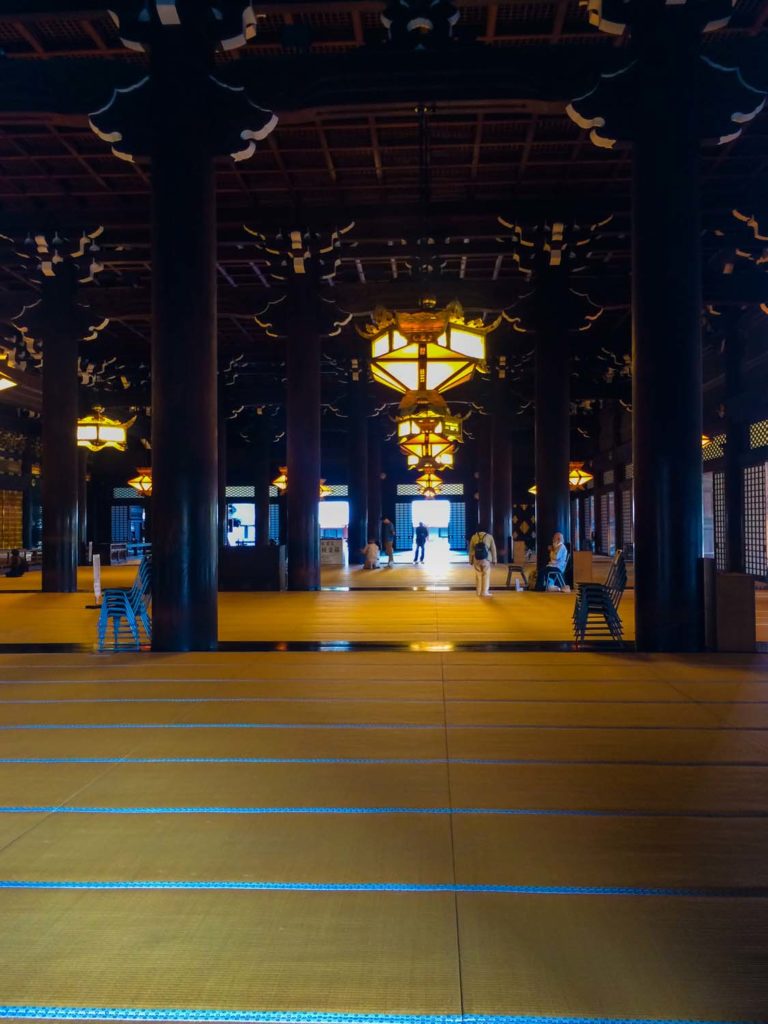
Amida Hall
Opposite the main hall, connected by a long wooden ramp, is the Amida Hall. This building was rebuilt in 1895 and contains a statue of the all-mighty “Amida Buddha.” Throughout the complex, you’ll pass through these large wooden walkways. The design of the walkways makes you feel as though they are extensions of the main structures, like limbs reaching out. Such a complex design displays the architectural prowess of the Edo period.
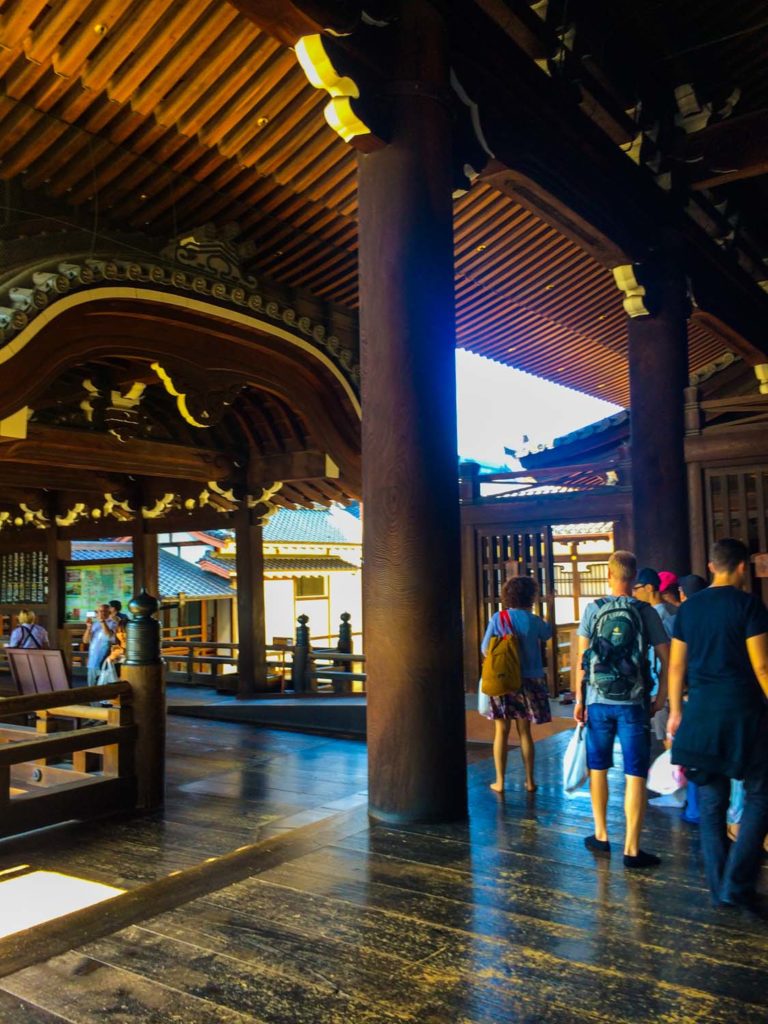
Dioramas
Outside on the walkway, you’ll find some small exhibits about the construction of the halls. In one, we can see a little diorama which depicts how the lumber was transported from the forests to the temple. In another scene, workers are fleeing an avalanche; some look like they’re not going to make it! The dioramas convey how some people had to risk their lives, so this temple could be created, and this exhibit pays homage to their sacrifice.
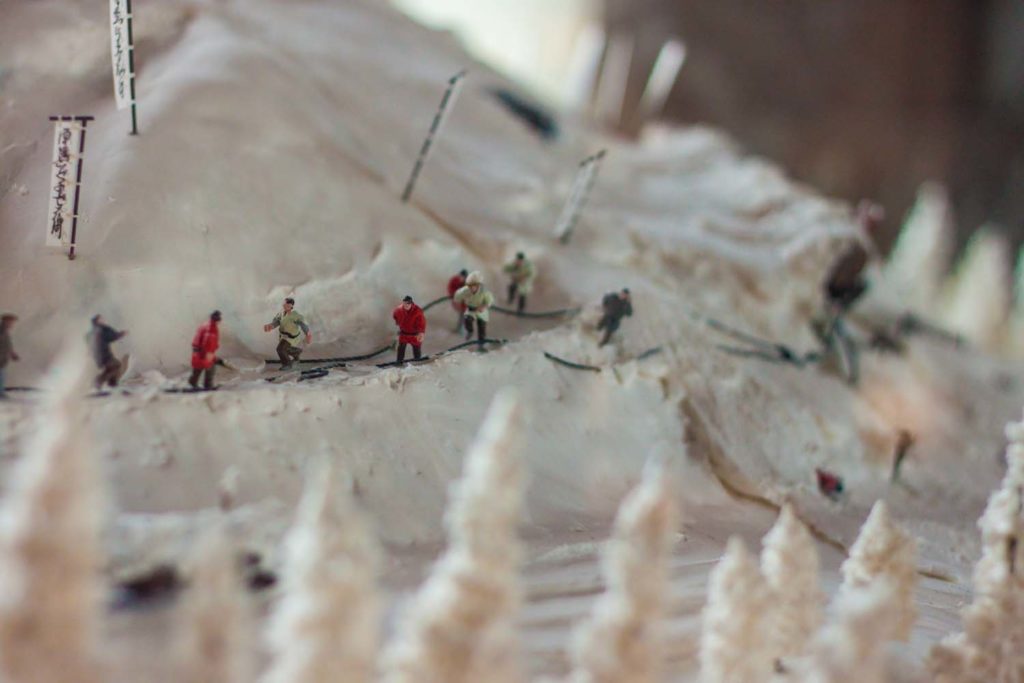
In another glass case, we can see an enormous, dark rope. It’s as thick as an oil drum and, shockingly, was created entirely from human hair. Female Buddhists would donate their hair to the temple to be turned into these strong ropes. This would help workers move the lumber into place and was one of the most important tools of the temple’s construction.
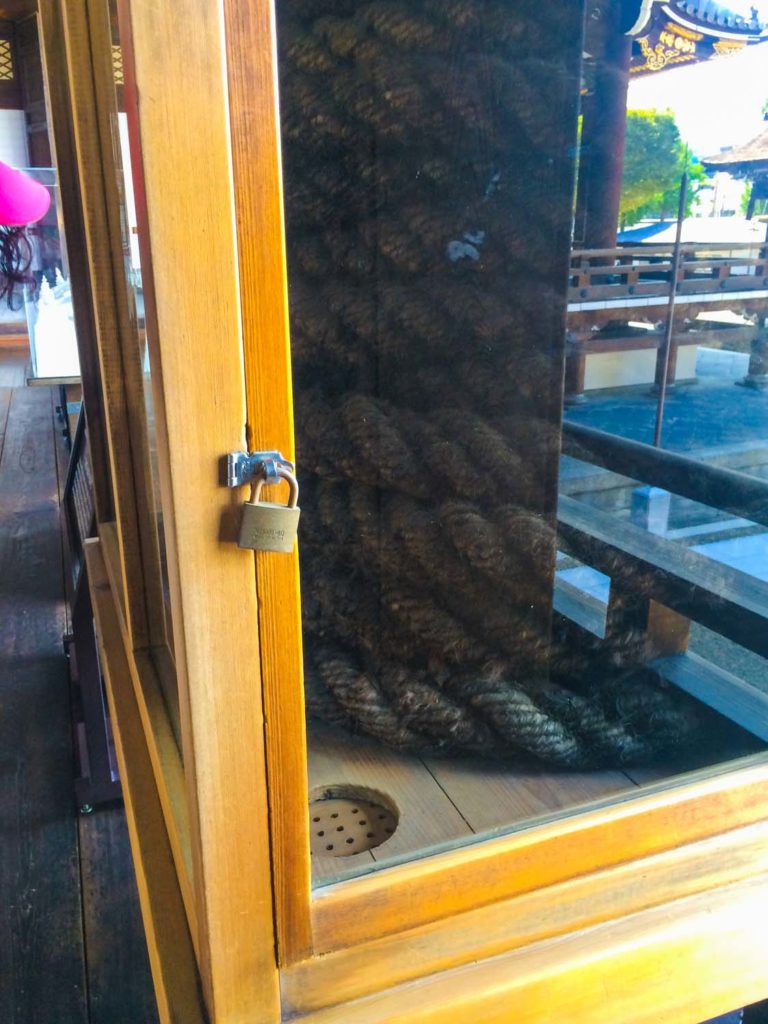
The Founder’s Hall Gate
Although multiple gates are used to access the temple grounds, the most impressive of all the gates is “The Founder’s Hall Gate.” The gate was built in 1911 and is over 92 feet tall. It is quite opulent and has two roofs, stacked one on top of the other. This creates a layered effect like on a pagoda.
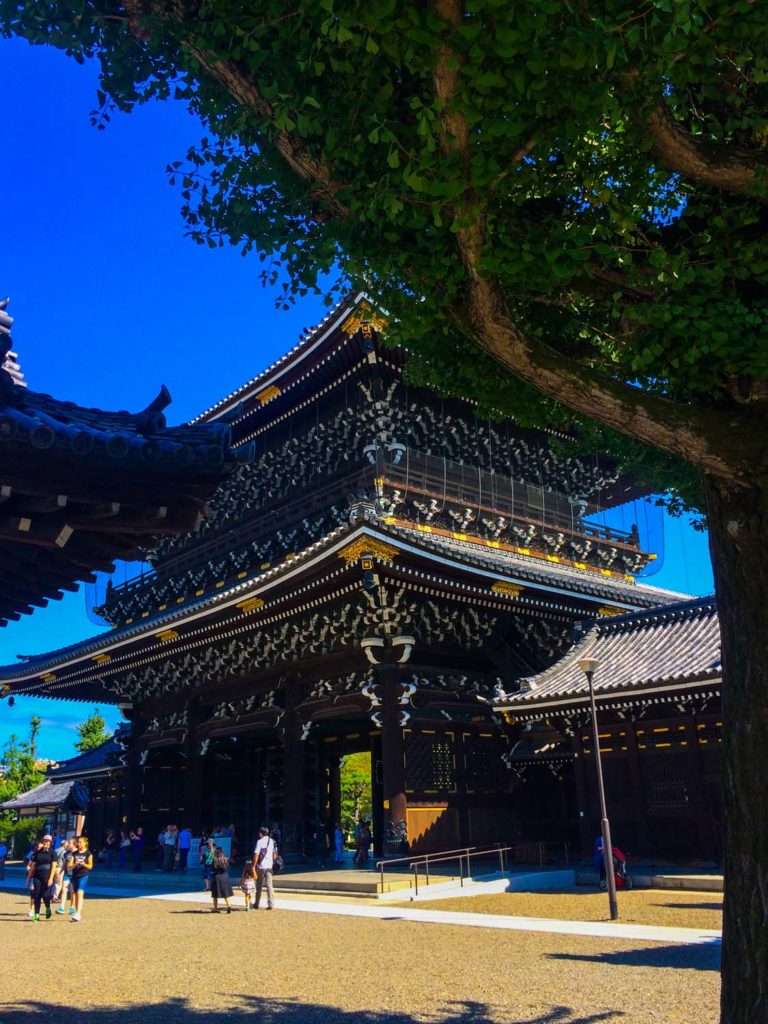
Along the temple’s exterior runs a small moat filled with lily pads and lotus, flanked by rows of Japanese black pines. The green trees set against the beige structures against a blue sea sky are one of the best colour combinations out there!
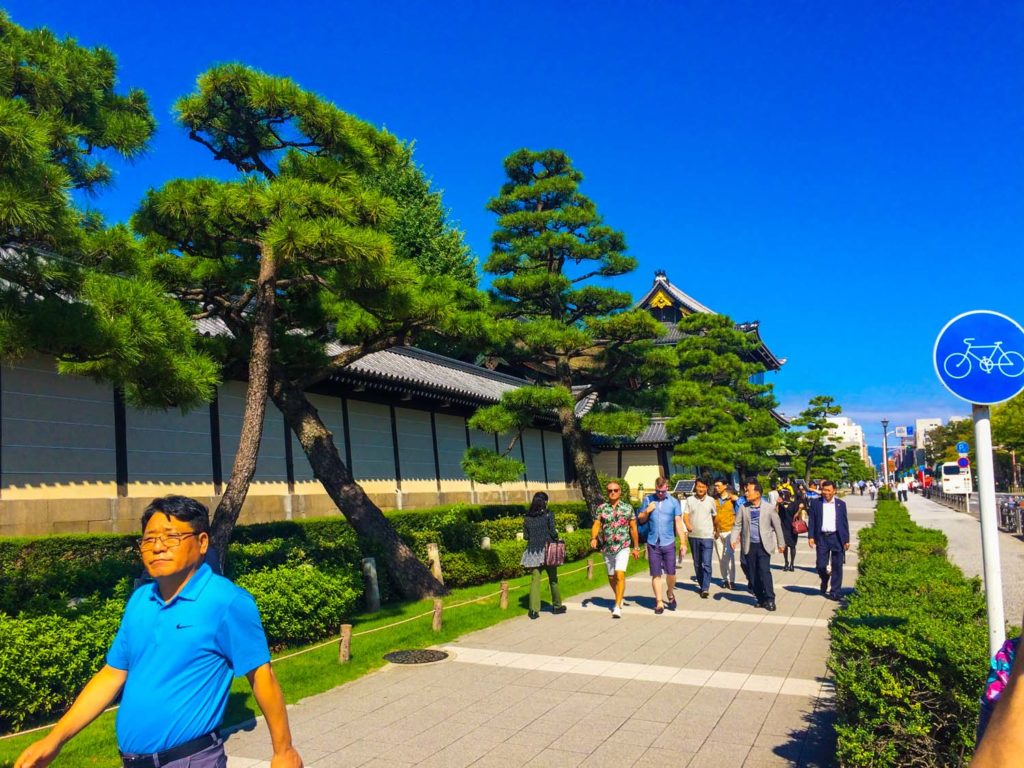
Kyosendo
After touring the temple, we head away from the tourists and into the real backstreets of Kyoto. Head to Kyosendo, where craftsmen and women keep old traditions alive. In this shop, artists create and assemble Japanese fans in the same manner as they have been made for hundreds of years.
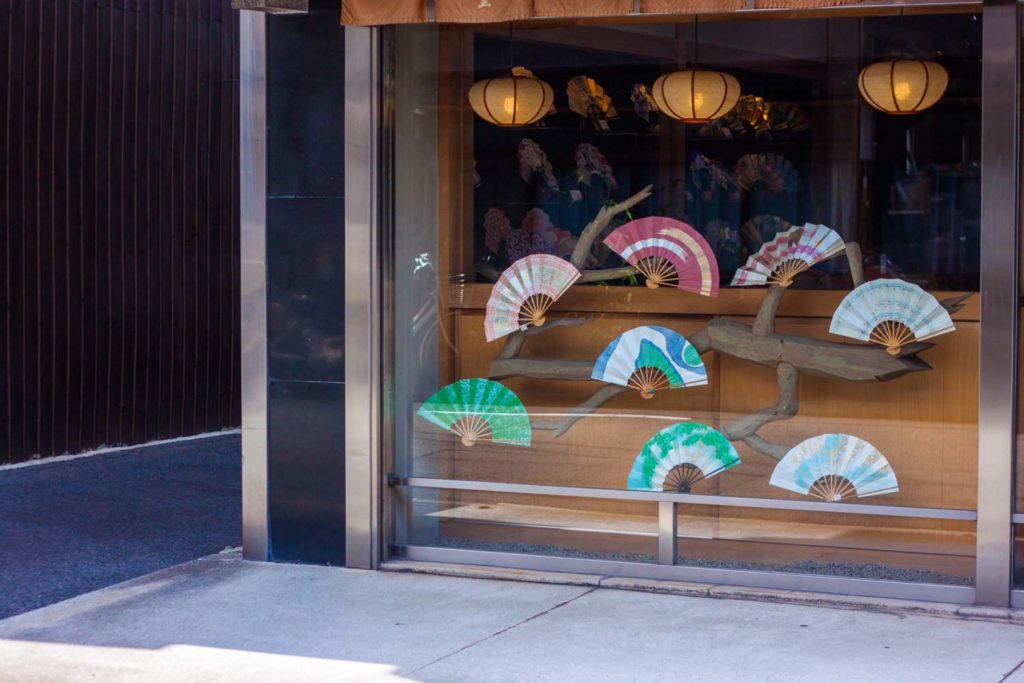
History of Japanese Fans
The first appearance of fans in Japan was in the early 6th century, brought over from China, although these fans did not fold but were completely flat. They were also very large and needed to be operated by a servant since they were too big to hold in your hand.
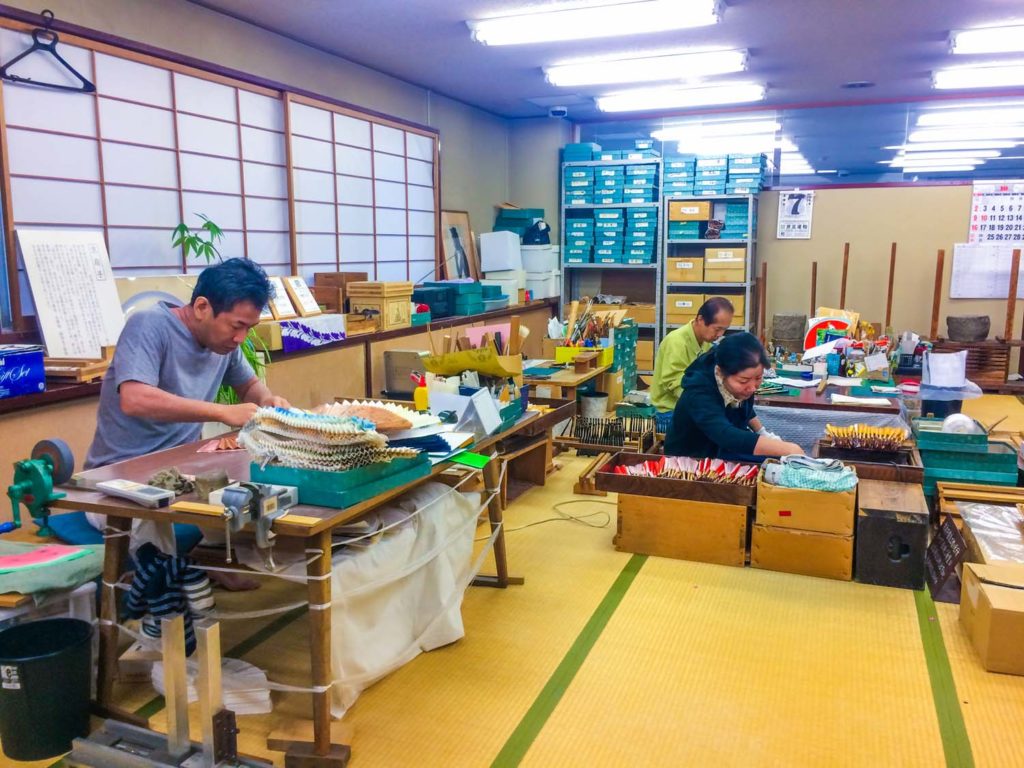
Legend has it that the Japanese folding fan was invented when a craftsman serving the emperor saw a bat and was inspired by the design of its wings. The fact that the fan could fold made it easier to hold in your hand when not in use and could travel more effectively.
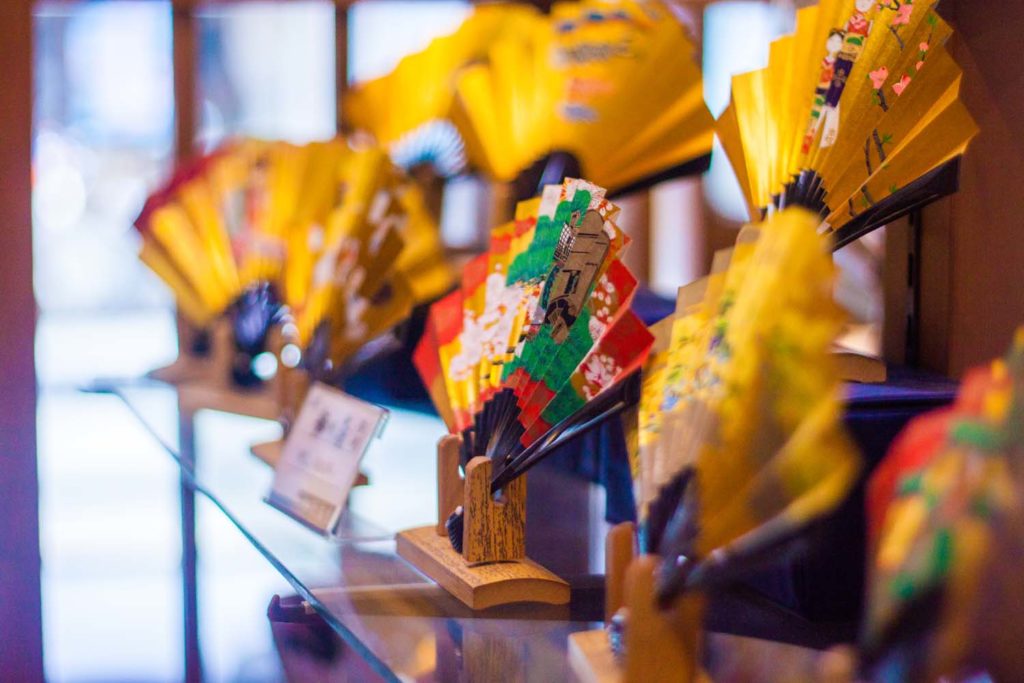
Varieties of Fans
There are three main varieties of Japanese fans; the feather, the folding fan and the brisé. Traditional Japanese fans are magnificently painted with images of pines, chrysanthemums, birds, plums, cherry blossoms and more! Every design contains a rush of symbols representing Japan or even hints at a theme important to the person for which the fan is being made.
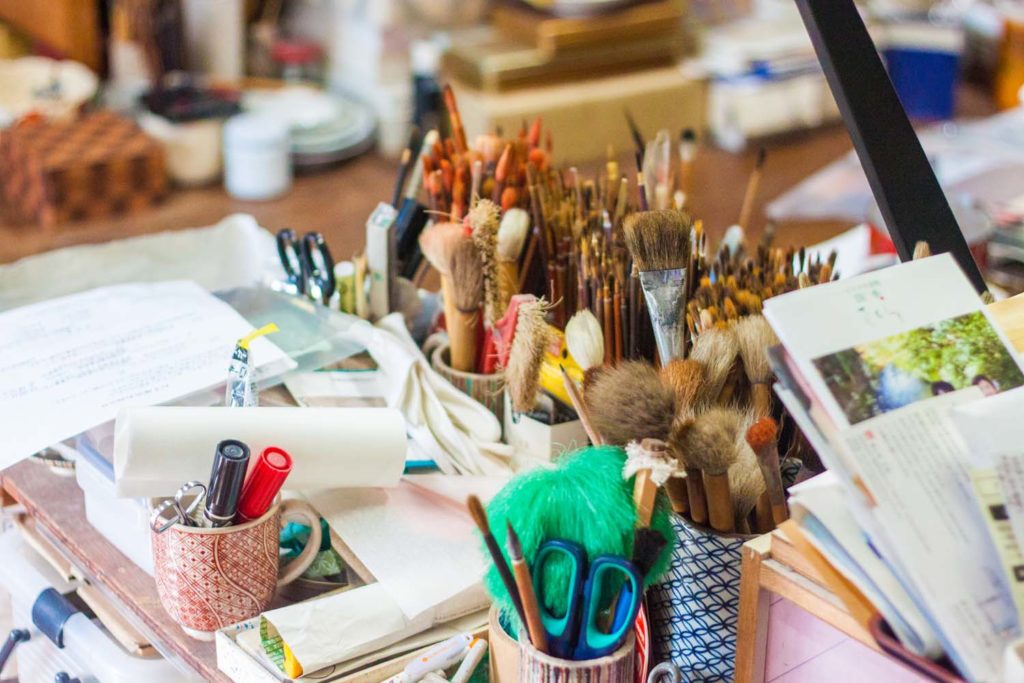
For 250 years, Japan remained closed off from international trading, and when its doors were finally opened, its exports were highly sought-after items. Japanese fans began flooding the North American and European marketplaces, some of the most fashionable accessories. At this shop, you cannot only look at the artisans still making these fans but buy one to take home for yourself.
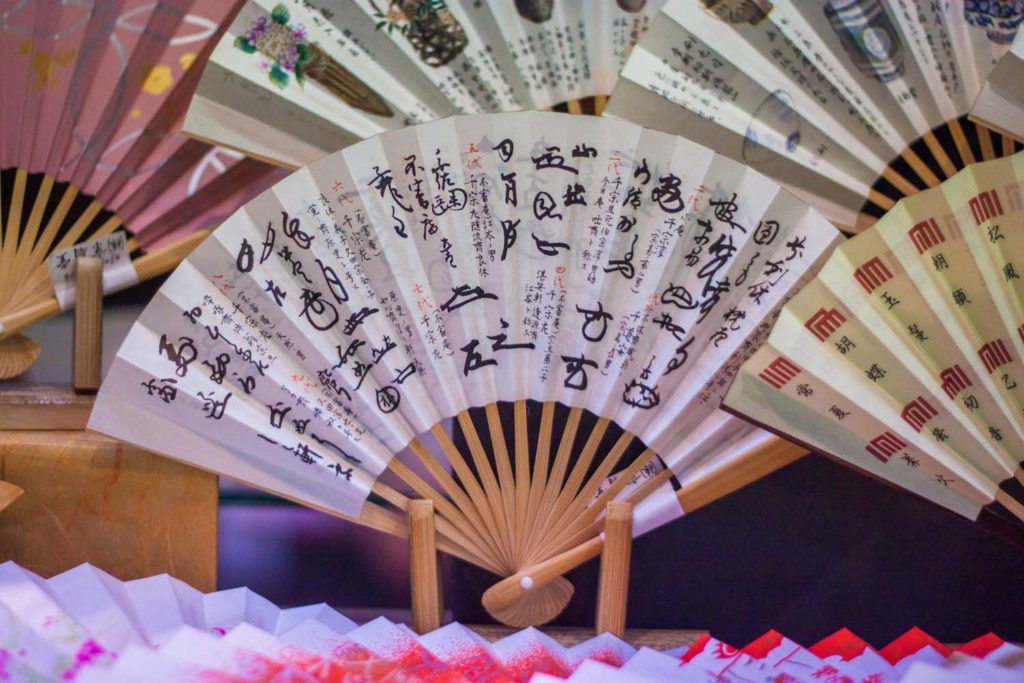
Tofu Shop
Opposite the fan shop, you’ll almost always hear a clamouring surrounding a glass refrigerator case. People come and go at all hours to buy fresh, locally-made tofu.
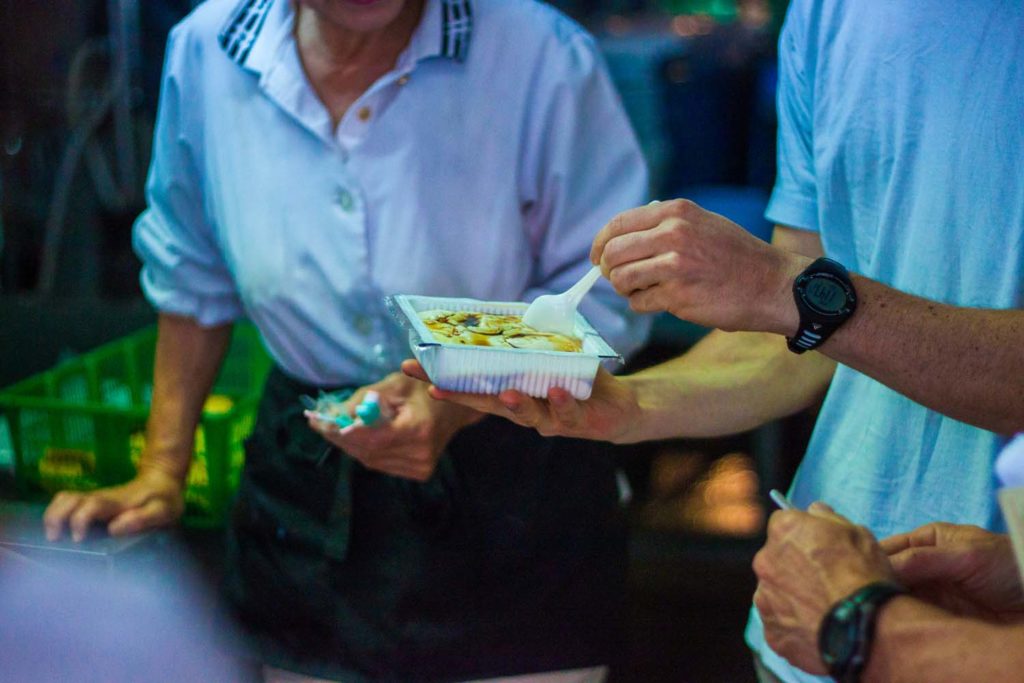
Inside the shop, there is a sweet fragrance that fills the air. Well-worn machines surround the outer walls of the shop, and women in aprons mull about pouring hot soy milk into plastic moulds. They sprinkled each square with magnesium chloride (which is the magic ingredient that turns soy milk into tofu.) Tofu is to Kyoto as pizza is to New York. Wide varieties are made all over Japan, but nowhere does it better than Kyoto.
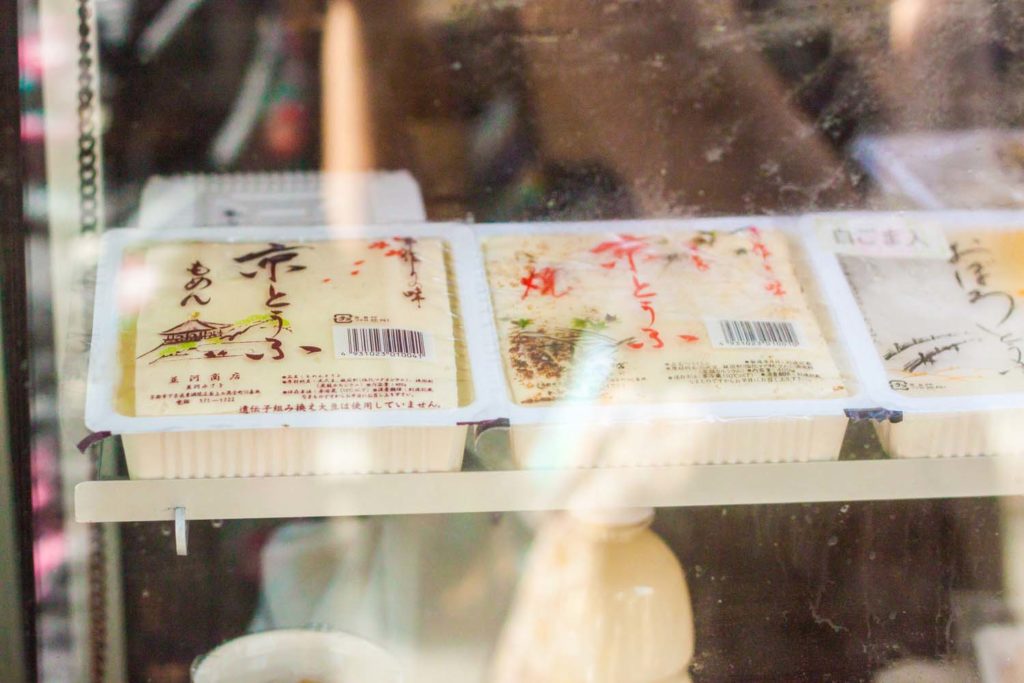
History of Tofu in Japan
The tofu was first brought to Kyoto by Buddhist monks in the 6th century, who could not eat meat or dairy as an alternative protein. This tofu is extra creamy, and you can taste just how fresh it is. It’s almost like pudding! In addition to tofu, they also made little pastry-like buns from the leftover soy, which people from all over town come to purchase at lunchtime. Try one for yourself! A great treat that ensures nothing goes to waste.
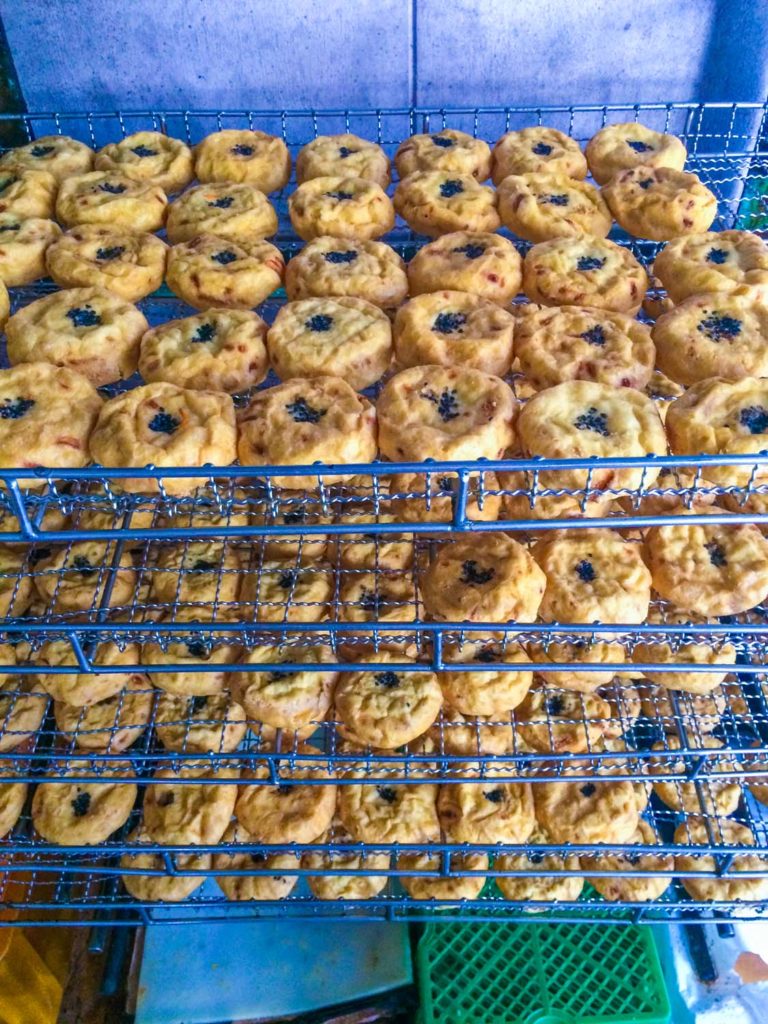
Ayako Tenmangu Shrine
Continue down the streets until you come upon the Ayako Tenmangu Shrine. Sitting outside the shrine is a large stone sculpture of a bull. The bull is the symbol of health in Japan, and this shrine is dedicated to bringing health to your body and mind. The shrine is very popular during exam season when students come here to pray for academic success!
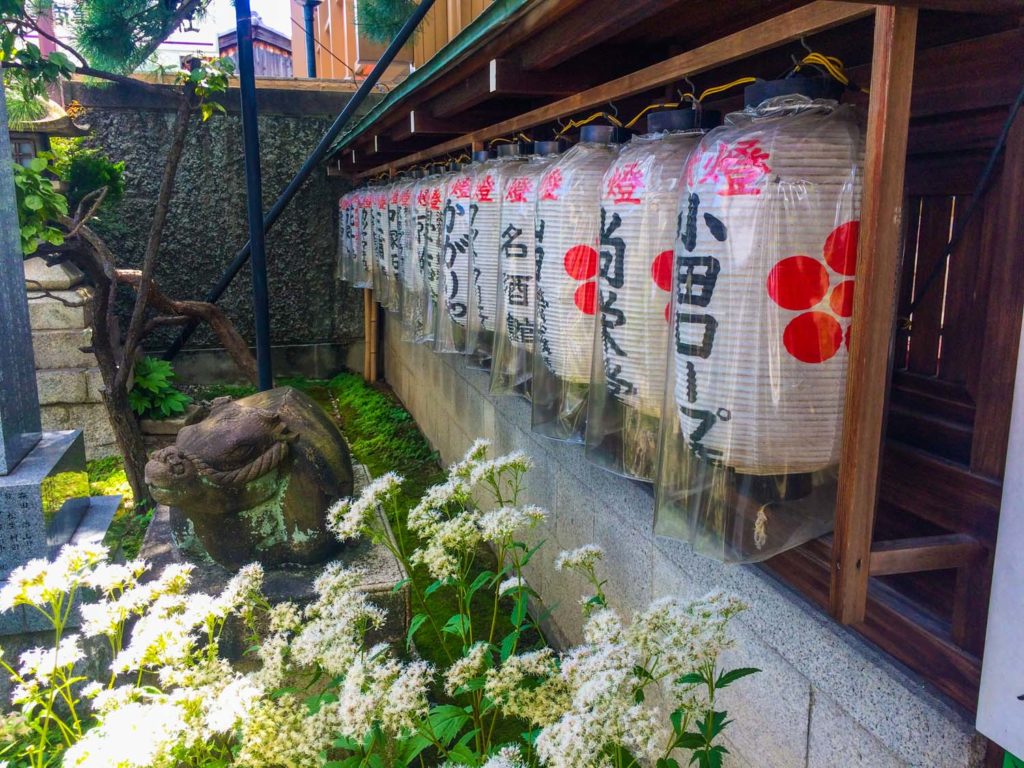
Walden Woods Kyoto
Fabric Stores
Along the backstreets of Kyoto, you’ll stumble upon almost every kind of shop! Some streets seemed completely residential, and suddenly, you’ll come across a high fashion kimono shop selling one-of-a-kind garments for Japanese weddings. These store hours are very sporadic, so I didn’t want to list anyone in particular, but weaving your way up to our next destination is a great way of discovering something for yourself!
Kimono shops, wedding kimono shops especially, are spectacular! The colours were stunning, and the amount of layering is almost impossible to imagine how these women managed to walk effortlessly and look graceful under all that weighty cloth. But fashion comes at a price!
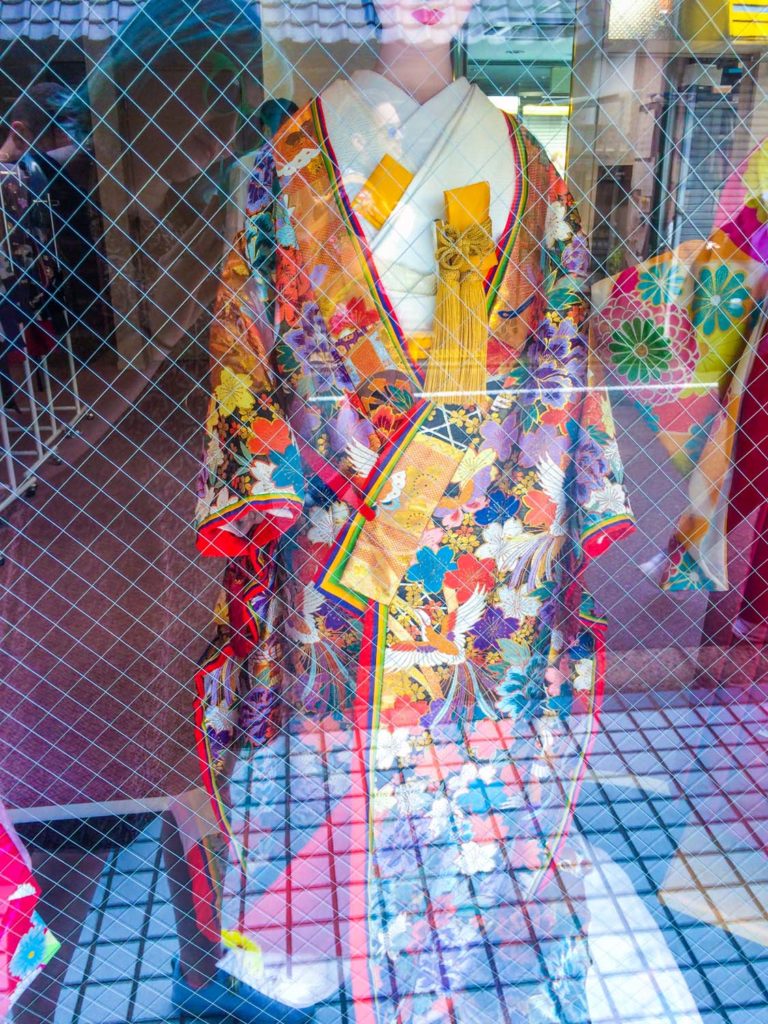
Family Cemetery
Stop at this family-run shrine and cemetery located at the northern end of town. Here you can take a moment to learn about how the Japanese experience death.
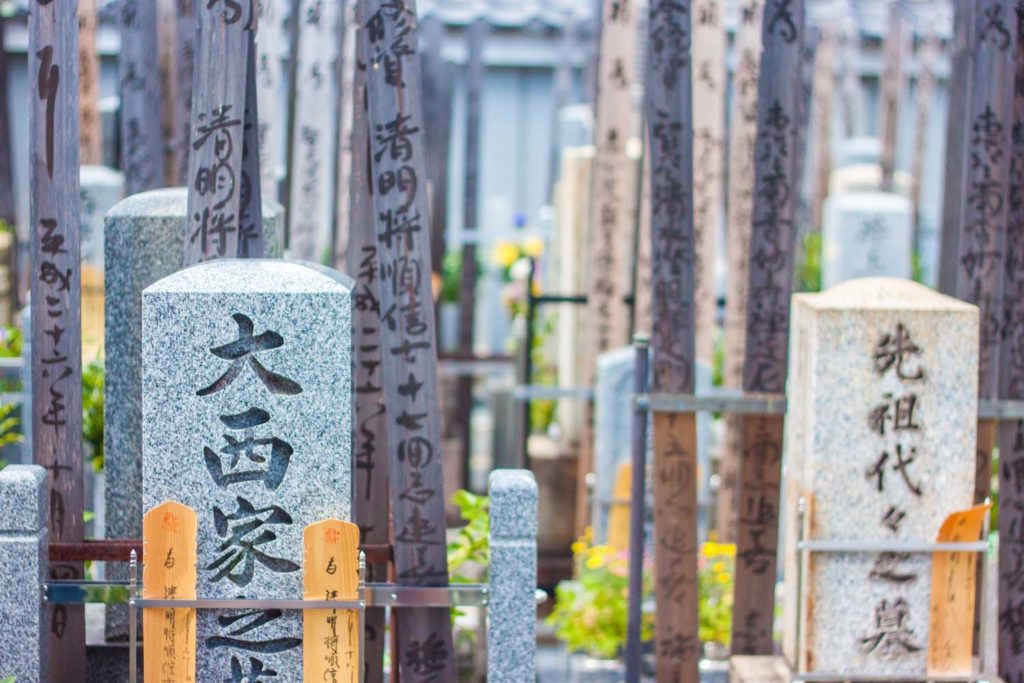
About Japanese Cemeteries
In Japan, entire families are buried altogether. One giant stone displays their family name, and the wooden sticks surrounding it refer to the different family members who have passed; unlike in North America, where we don’t visit cemeteries all that often, it is very common in Japan to visit your family tombstone weekly. You would bring with you things your loved one cherished in life, like; beer, food or even sometimes something to read. Japanese families keep their loved ones close, even in death.
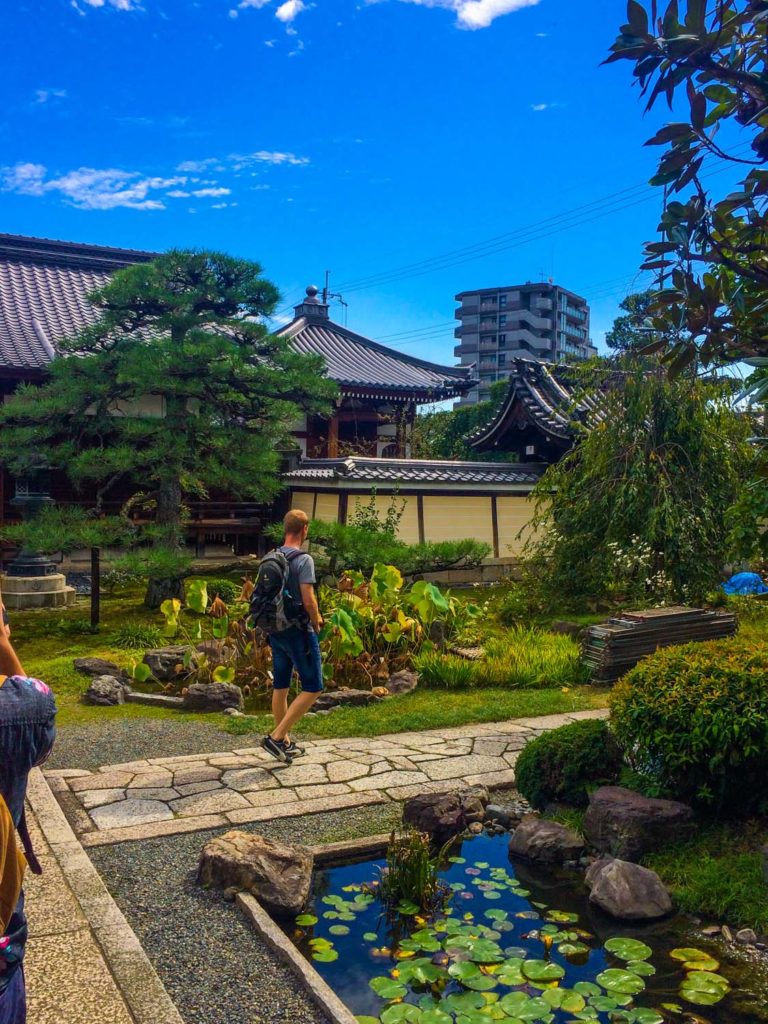
Ichihime Jinja
After a short rest or a beverage stop at one of the many street vending machines, head back out to find the Ichihime Jinja shrine. Ichihime Jinja is best known for its protection of women. All the gods worshipped here are female deities. The shrine was once even featured on a popular Japanese TV show, and ever since, women from all over the world have come here to receive the blessings of the maternal deities.
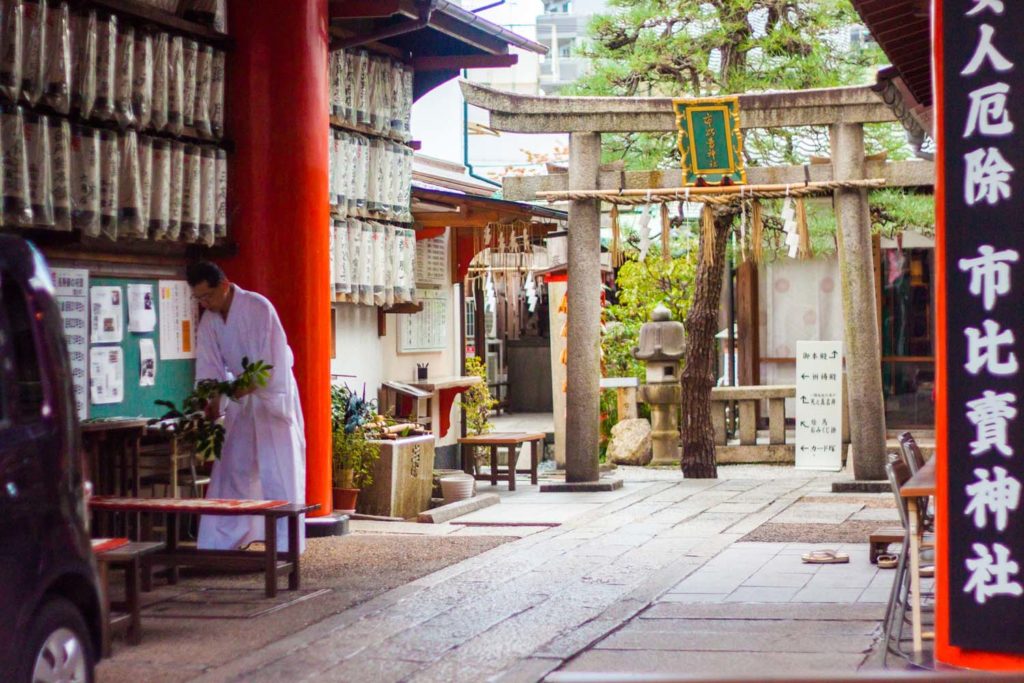
Omikuji
The Omikuji fortunes at this shrine are unique as they are stuffed inside cute, red wooden dolls in the shape of a lady. Each one has a different hand-painted face and holds within it a secret fortune. If you receive a negative fortune, tie it up on the wall with the other to ensure the bad omen doesn’t come to pass.
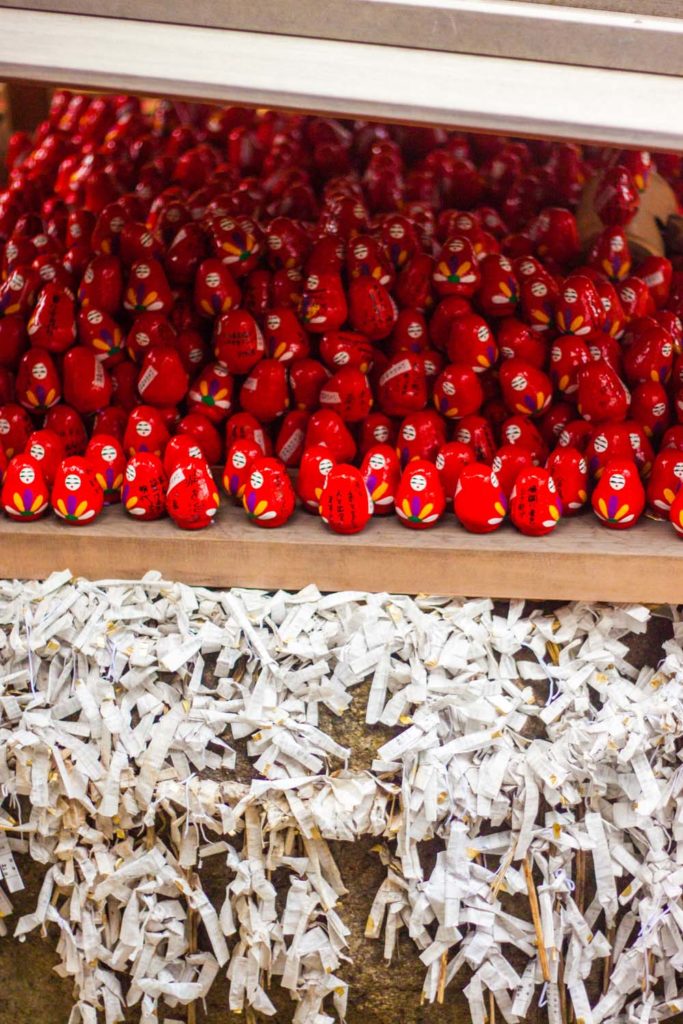
How to Pray
Towards the back area of the shrine is where you’ll find the haiden. This is where you pay your respects to the gods. First, drop a coin into the offering box. Next, you need to ring the bell. Ringing this bell is important in the prayer process as it lets the gods know you’re there. Ring the suzu bell, bow twice, clap your hands twice, and bow once more.
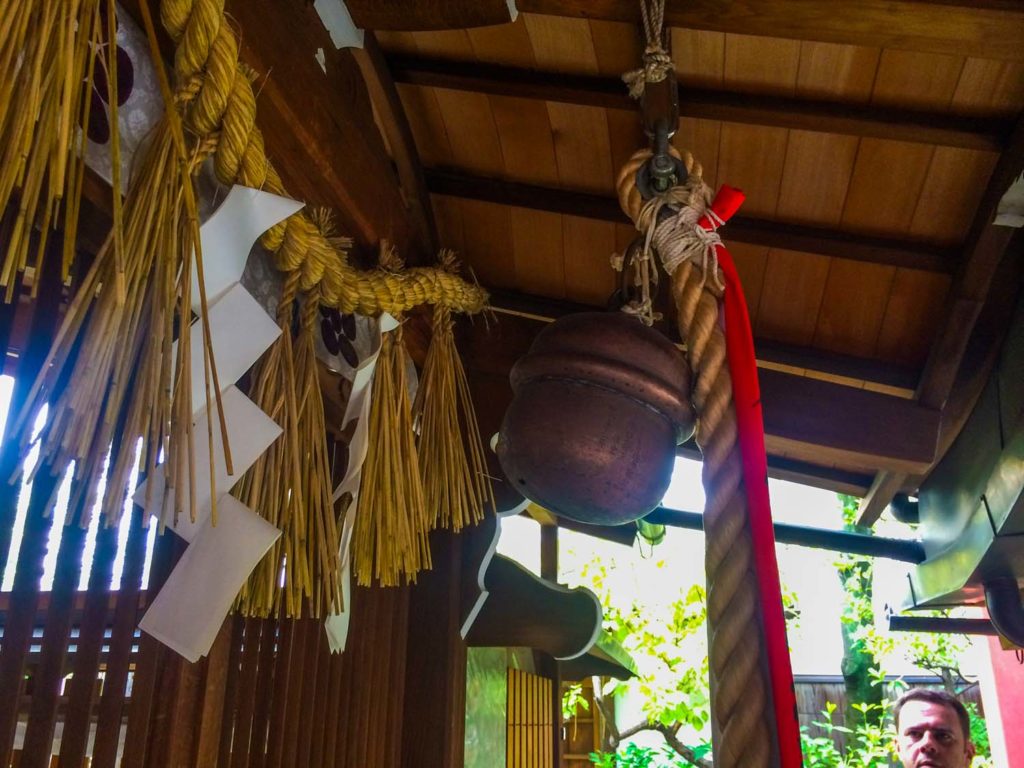
Ame-no-Mana-I Well
Besides the shrine, you’ll find the famous Ame-no-Mana-I well. This well was once used by royal families, and it is said that cleansing yourself in the springs of the well will result in your wish being granted.
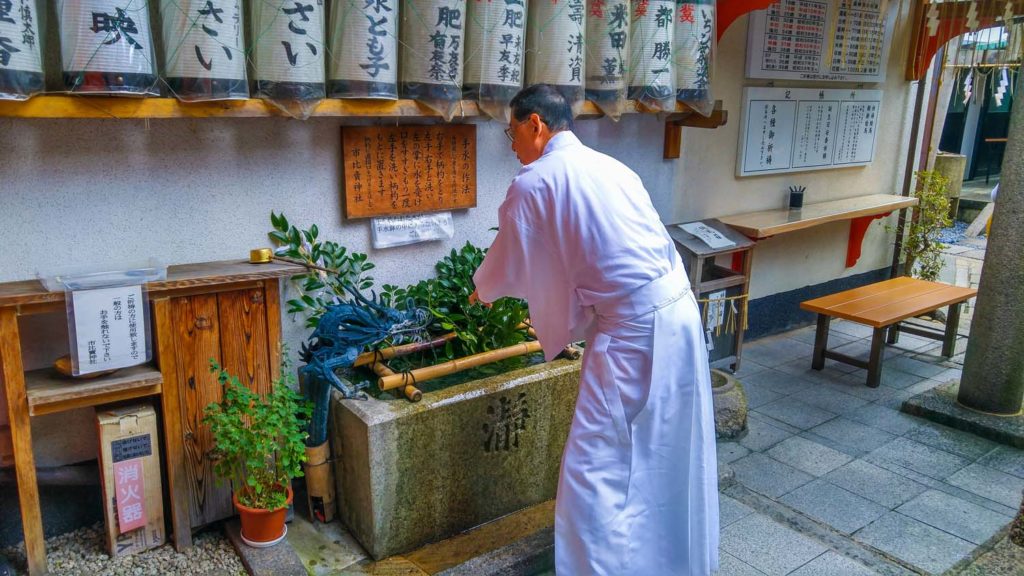
Gojo Rakuen
Further along, find your way to the Gojo Rakuen area. This neighbourhood used to be the old red light, Geisha district. Although real geishas weren’t like prostitutes (they were more like companions and entertainers), various women of the night would dress like geisha and offer up their “services” to gain a particular type of clientele in this area. Brothels inside wooden teahouses were once the main establishment on these streets.
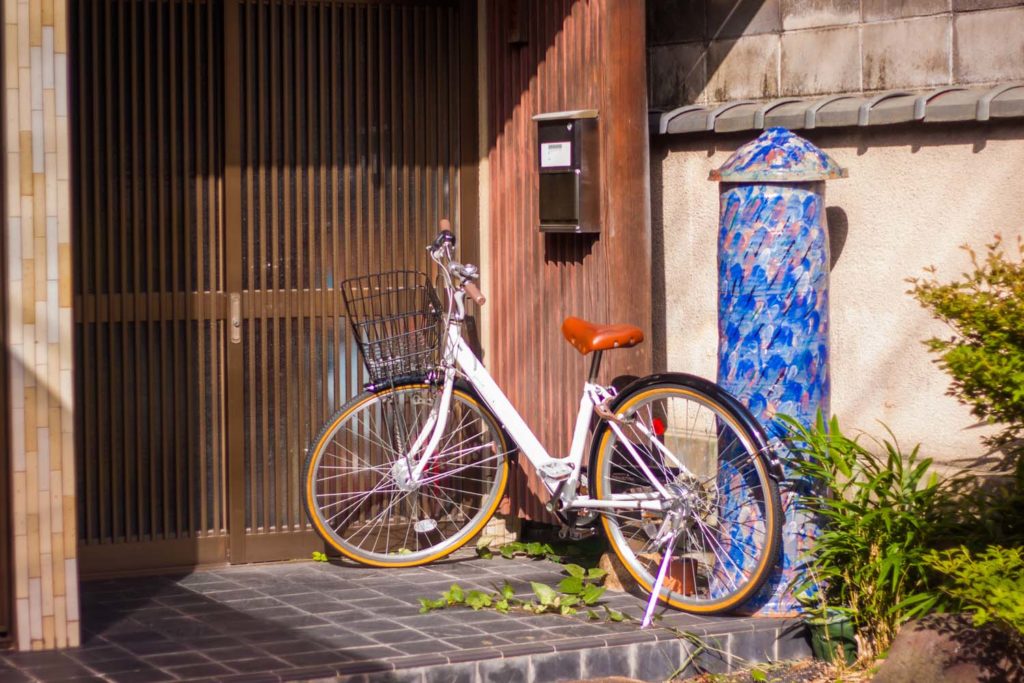
Fifth Street Paradise
Gojo Rakuen translates into “fifth street paradise.” That “paradise” refers to all the “pleasure” services once offered here. A strange feature could identify these houses of ill-repute. Unlike the red lights district in Amsterdam, where the houses were lit up with red lights to identify them as brothels, Japanese brothels were identifiable by having a fish tank outside their open door.
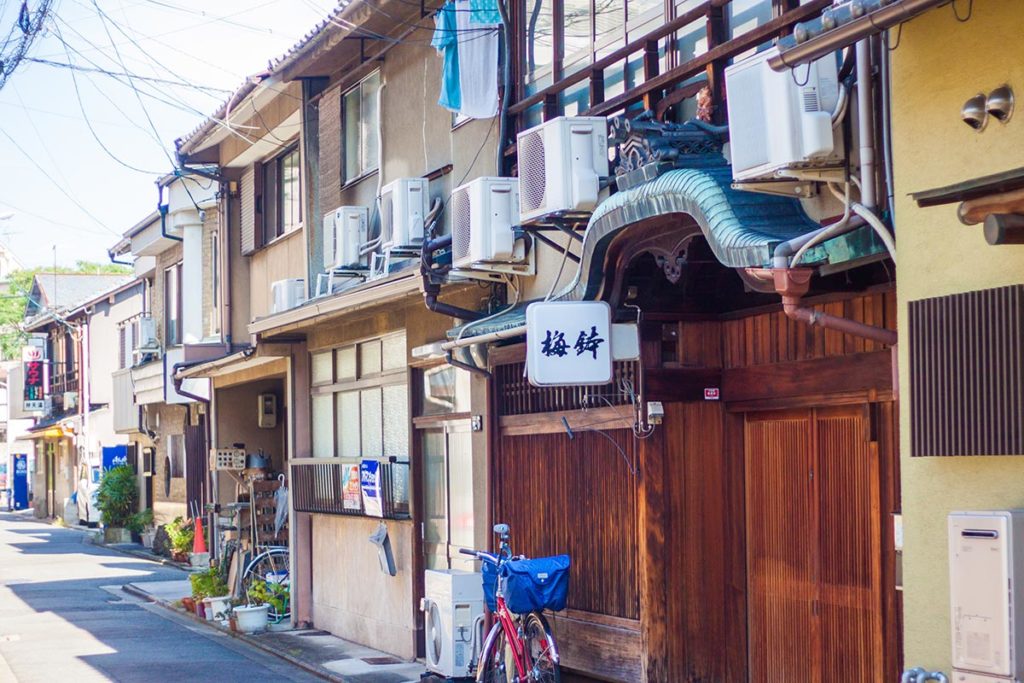
After becoming a seedy part of town, many branches of the Yakuza (the Japanese mafia) also moved into the area, making it an off-limits place for many Japanese people for years. Only now, after the Yakuza had been exiled from Kyoto, can people walk these streets without fear.
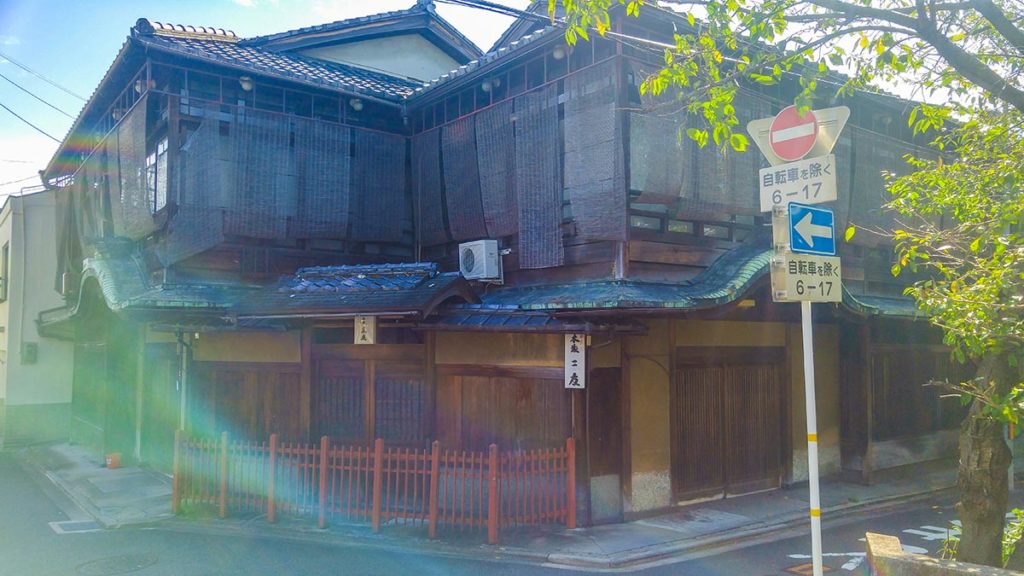
Takase River
Unlike European cities, where houses along the river bank are seen as some of the most desirable properties in the city, the houses along the riverbank in Kyoto are old, wooden townhomes. Some almost falling apart. They are humble houses that have yet to be swept up in the wave of urbanization.
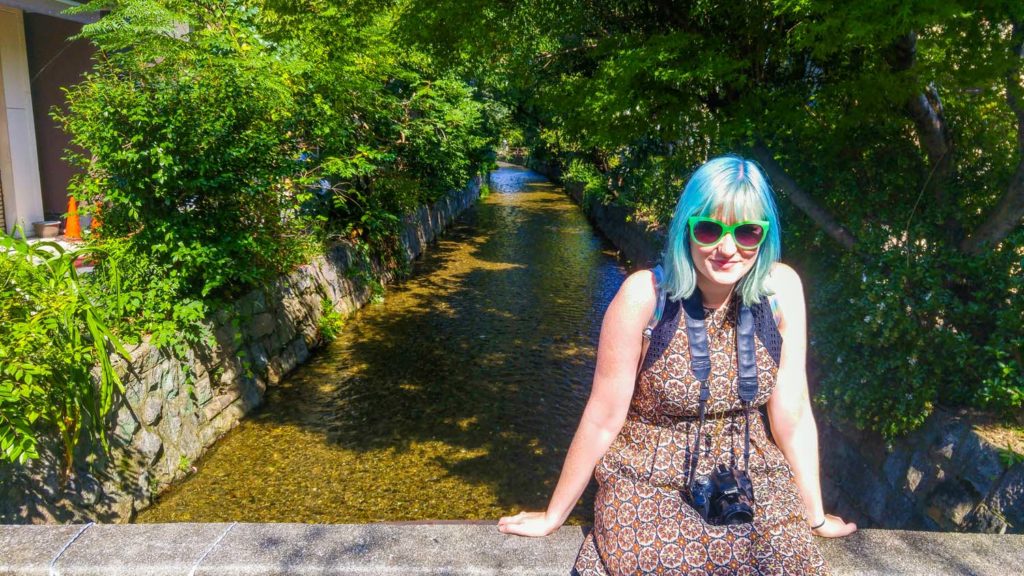
Walking through these streets, many old tea houses and traditional restaurants remain. No trendy cafes or loud bars. These streets keep the vestiges of the old ways. Take a minute to stop along the bridge across the Takase River for a hydration break! It’s amazing in a city as famous as Kyoto, you can find such peace and quiet.VVVVVVVVVVV
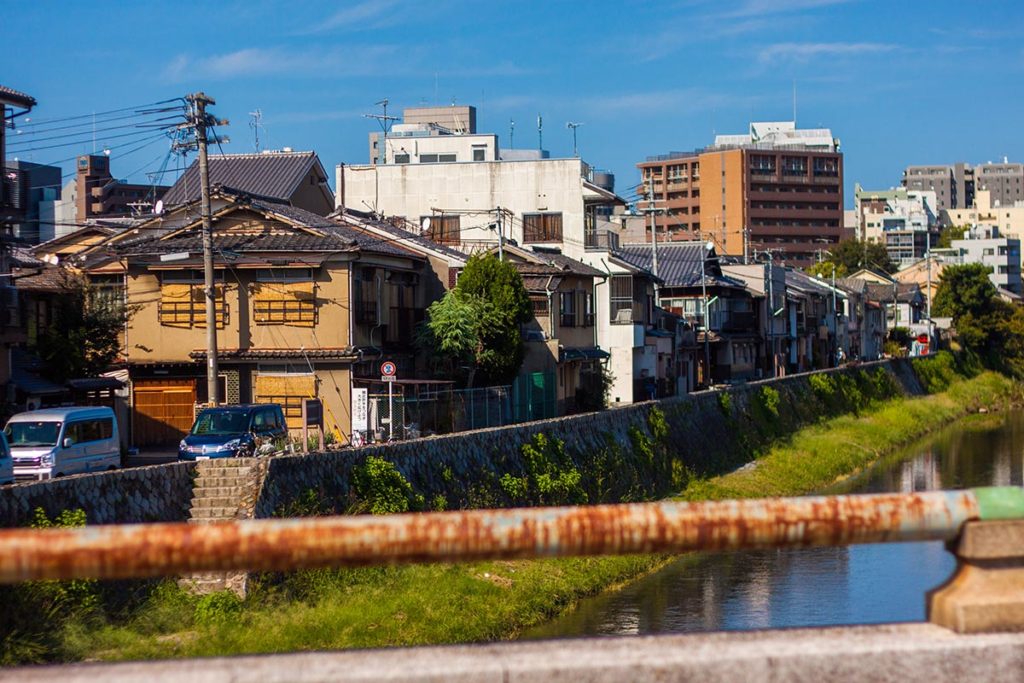
Artists Studios
Due to the run-down nature of this area, and the low real estate prices, artists began to flock to this part of town. Here they could work on their craft; soon, these backstreets became a wash of artists and craftspeople. Walking, you might see people selling wares outside their front door. No official shop, just ceramics laid out in a box with an honour system for payment. I managed to poke my head into a small studio with open doors.
Inside, an old Japanese woman, surrounded by paint brushes and books, sat there painting the tiniest details onto a minuscule clay figurine. Japanse pottery is one of the oldest art forms in the country, and this woman was preserving its legacy. Surrounding her were hundreds of reference books, patterns, antique pottery and more.
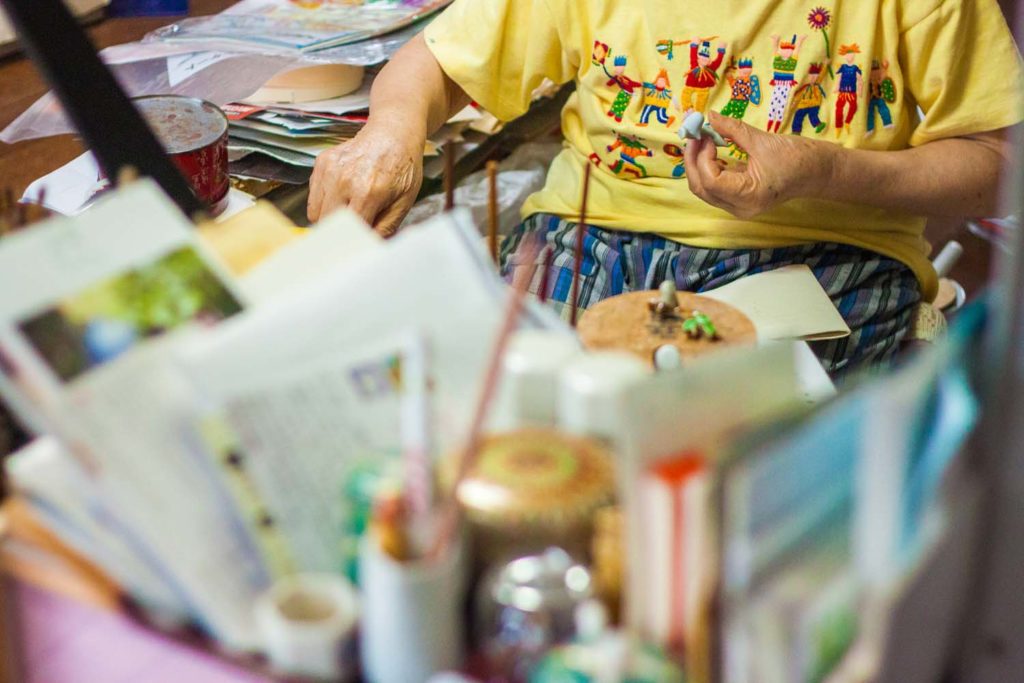
Visiting Artists Workshops
Her face was so serious, but when she looked up, and I complimented her on her work, she smiled so wide – even after all these years, it still made her happy to see her work was appreciated. Hidden in the nooks and crannies of her studio were some of her pieces ready to be sent to high-end shops all over Kyoto.
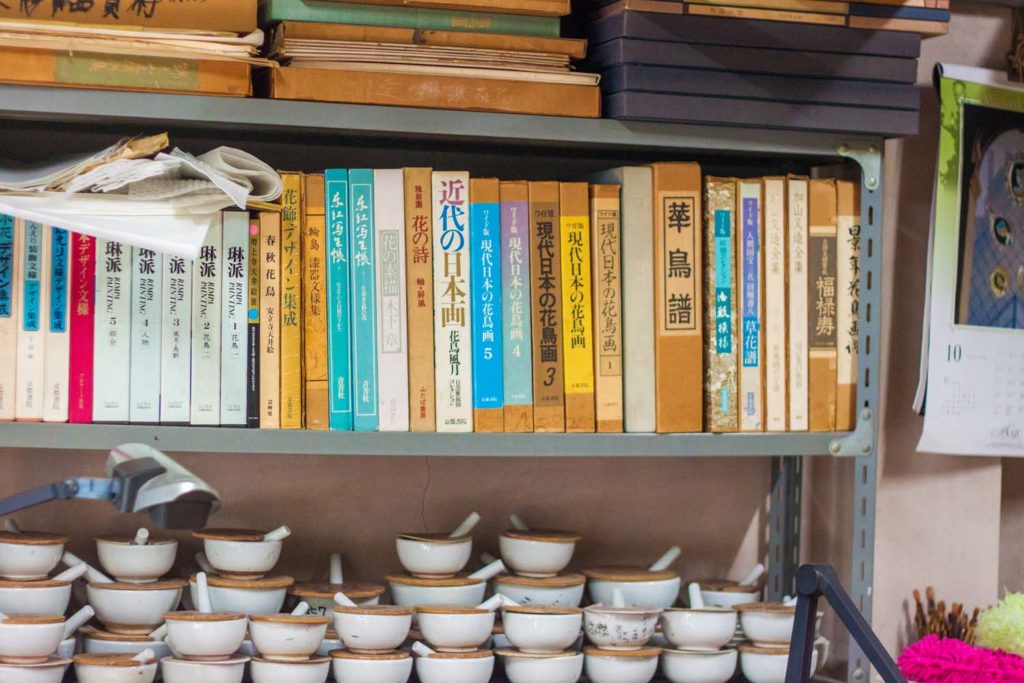
Yamauchi Nintendo
Before heading across the bridge, we passed the former headquarters of Nintendo. This was their main location when Nintendo was just a Japanese playing card company established in 1889. Long before it had anything to do with Mario or Luigi. Inside this building was where Pokemon was first invented. The quiet street was very unassuming, and it was unbelievable that years later, Pokemon would become one of the most popular past times for kids worldwide.
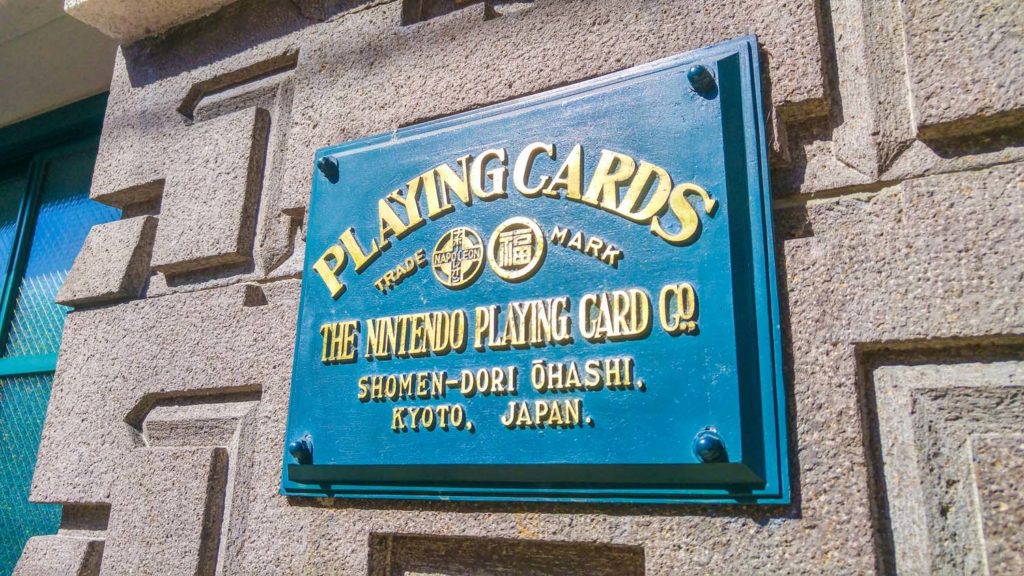
Shomem-bashi Bridge
Crossing the Kamogawa river, we head over the Shomen-bashi bridge. This is a more modern bridge than the original one, which once stood here. It was built in 1952, but nonetheless, it keeps in line with the aesthetics of the area’s original architecture.
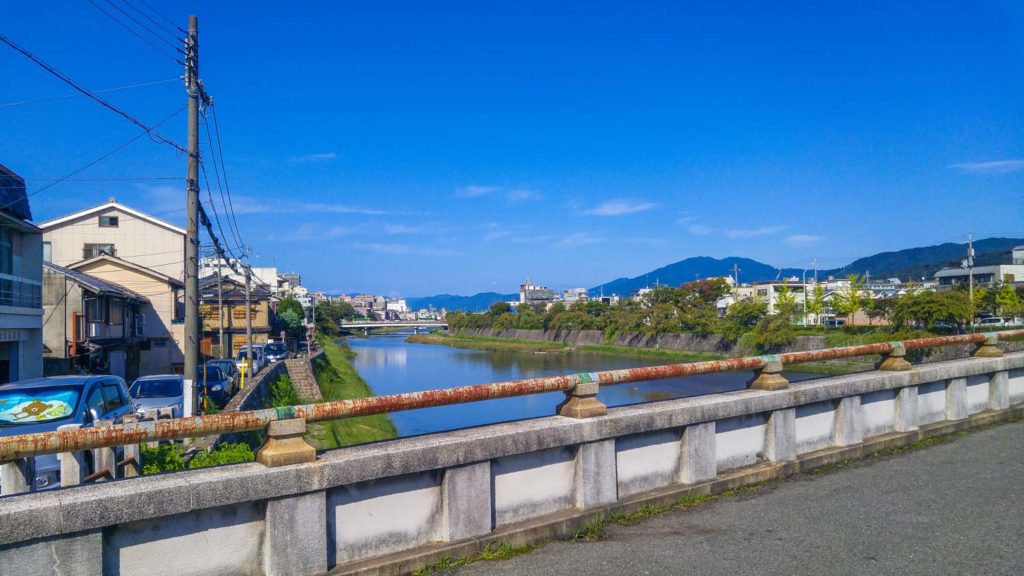
From the bridge, you can see both sides of Kyoto and the mountains in the background. On hot summer days, the riverbank is filled with tourists and locals relaxing alongside. On either part of the riverbank, balconies from restaurants and old townhouses overlooked the waters.
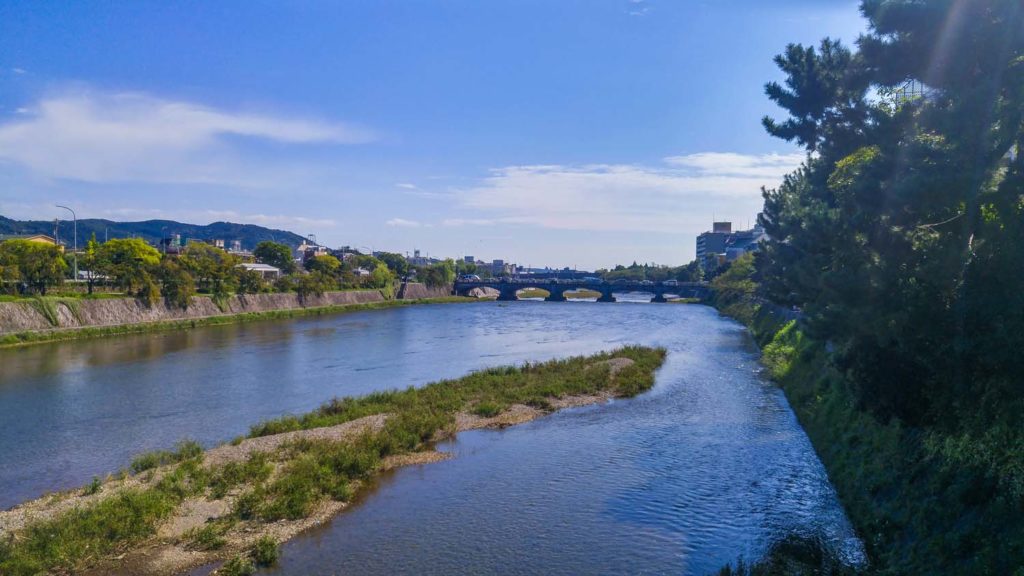
Kanshundo Higashimisea
Across the bridge, stop at Kanshundo Higashimise. This traditional candy shop has been in business for over 150 years. The sweet shop sells wagashi sweets made by skilled artisans who turn sugar into coin-sized delicate works of art in all magical shapes. These handmade treats always have seasonal touches. Since it was autumn when we were there, the chefs had different autumnal flavours added to the wagashi.
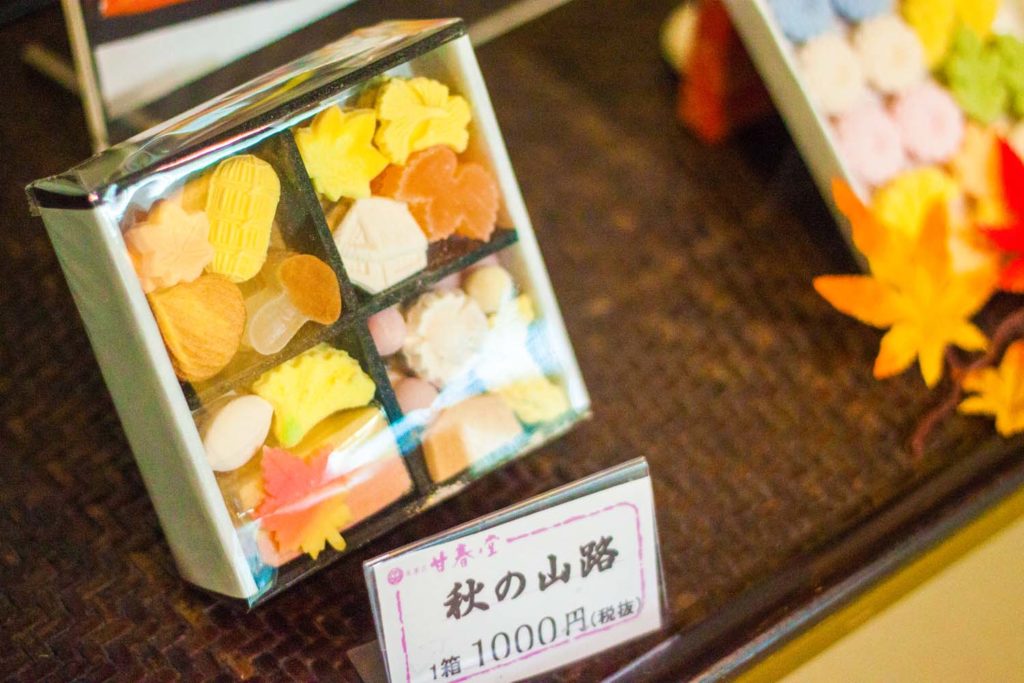
Wagashi
Take a seat at the back, where you can order a cup of green tea and a sample of one of their handmade desserts. The wagashi was made to perfectly complement the slightly bitter flavour of the green tea.
The ingredients for wagashi are fairly simple; it’s only sugar, rice flour, and some additional flavouring. But the decoration, shape and complex flavours make an otherwise simple treat into something fantastical. These treats are often served at tea ceremonies or special occasions.
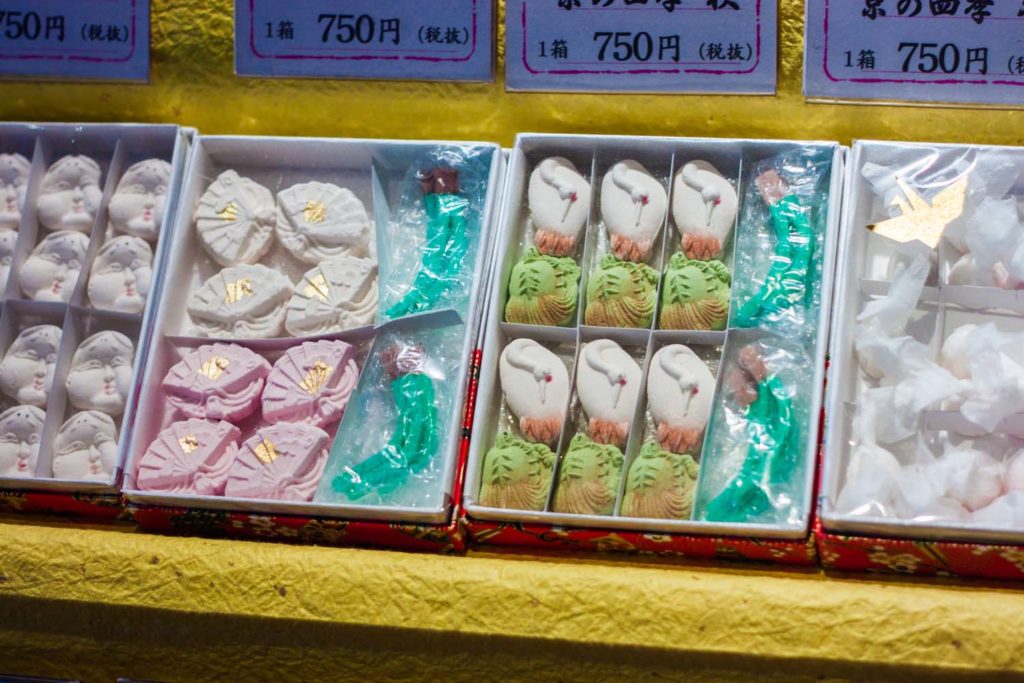
Toyokuni Shrine
After a quick snack, head over to Toyokuni Shrine. Originally constructed in 1599, the shrine was built in memory of the great leader, Tokugawa Ieyasu. Tokugawa Ieyasu wanted to be treated like a god after his death and had his followers build this great shrine where people could worship his memory after his passing. But his popularity proved to be his demise, even after death. The next ruler, Toyokuni, was jealous of the dead leader’s reputation and had the shrine destroyed. The new leader had a new shine built in his honour on the same spot. Just to spite the old ruler.
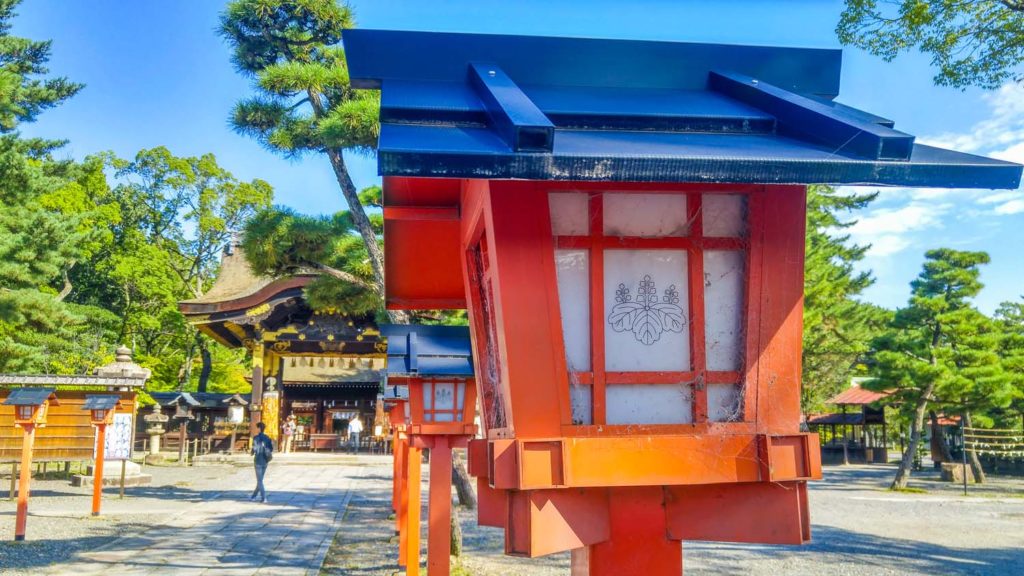
Karamon Gate
The karamon gate you walk through to enter the shrine is rumoured to have been moved from the historic Fushimi Castle. This gate is one of Japan’s most iconic karamon gates, and people travel from all over to view its striking architectural design. Despite being over 400 years old, much of the gold leaf decorating the outside of the gate is from the original structure. The gate has been so lovingly cared for; therefore, even the oldest details were well preserved.
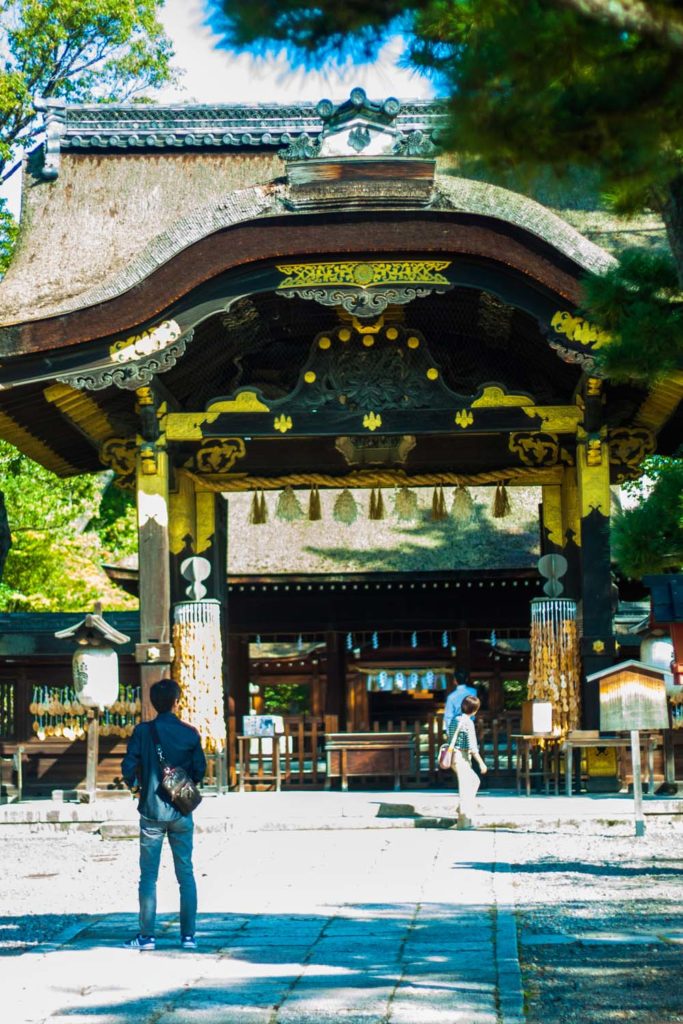
The gate was built in the Momoyama period when Japanese architecture broke away from many aspects of Chinese architecture to create its own style. Carved onto the gate are images of cranes made by Hidari Jingoro, one of the most famous carvers of the 16th century. The cranes all possess no eyes because, as the legend goes, if they had eyes, they would simply fly away and not stand and protect the temple.
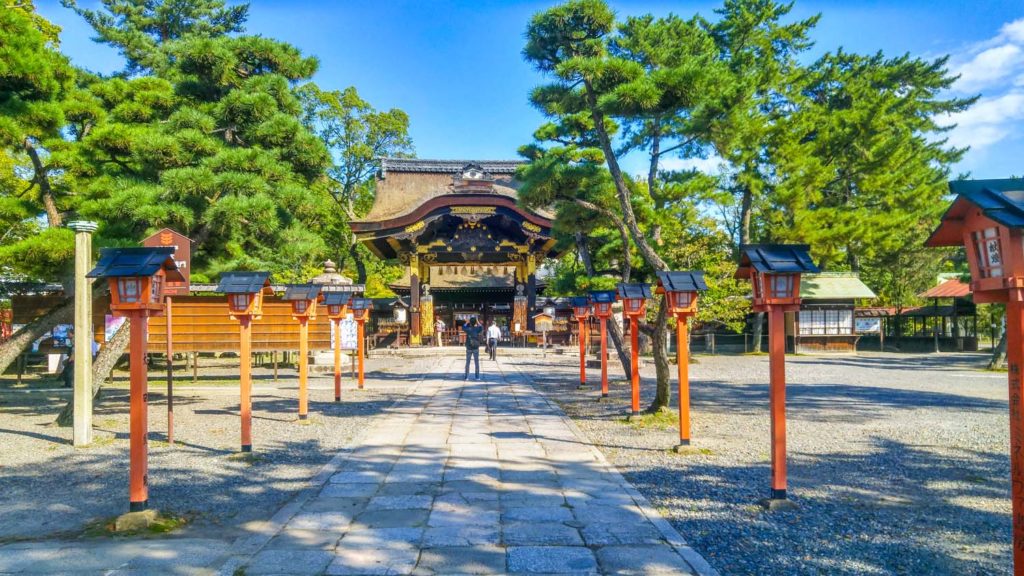
Toyotomi Hideyoshi
Entombed inside the shrine is Toyotomi Hideyoshi himself, and many people visit the shrine simply to pray near his tomb. They hope their prayers will transfer some of his power to them.
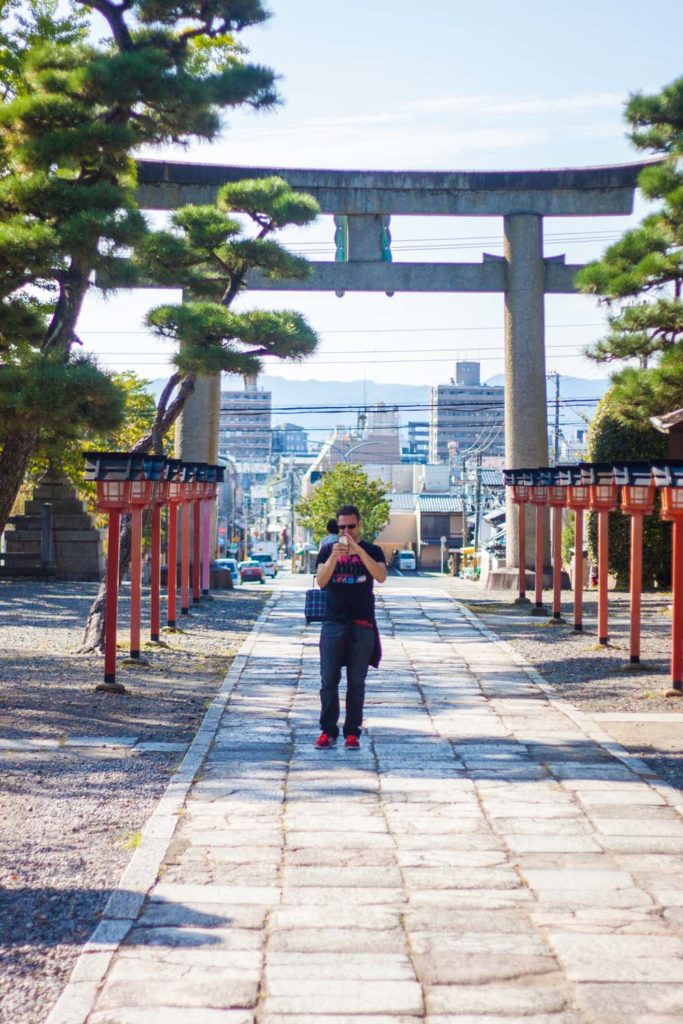
Toyotomi’s family crest is a cluster of gourds. Today, you can purchase an ema in the shape of a gourd. Emas are wooden prayer plaques where worshippers can write their prayers or wishes. Another popular item the shrine is known for is its amulets called “Samuhara,” which are said to ward off misfortunes.
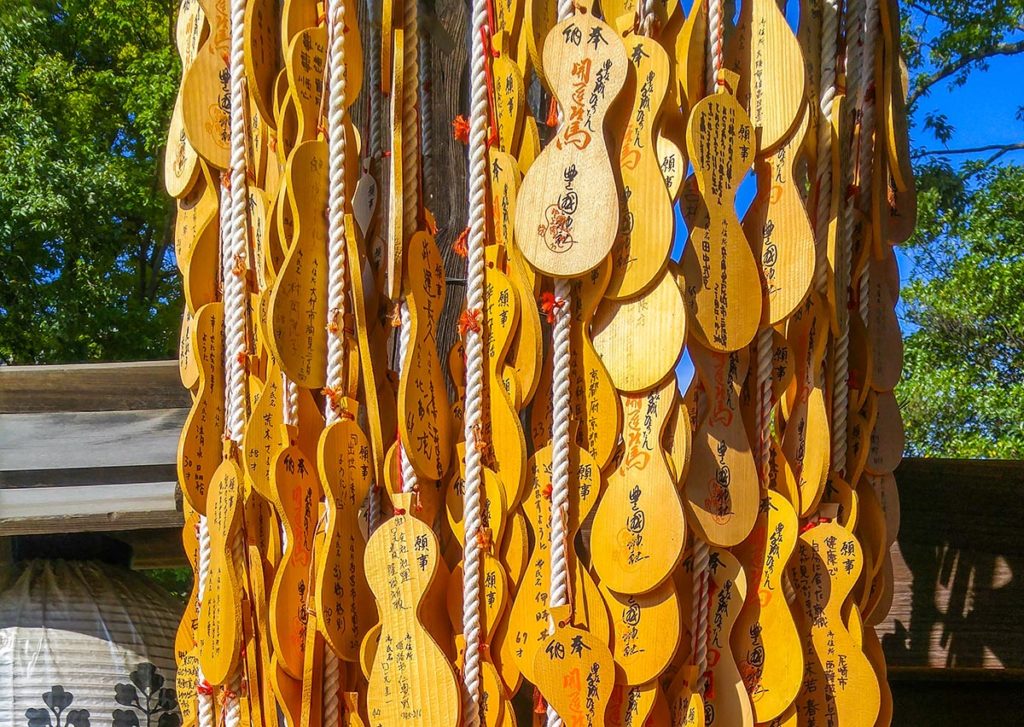
Hoko-ji Temple
Adjacent to the shrine is an ageing temple containing an enormous bell. These are the remnants of the ancient Hoko-ji Temple. Hoko-ji Temple was once one of the greatest temples in Japan, but after many wars, earthquakes and fires, all that remains is the giant bell. This part is hidden off to the side of the temple, sitting in the middle of a run-down parking lot. But it is absolutely worth your time to come and see it!
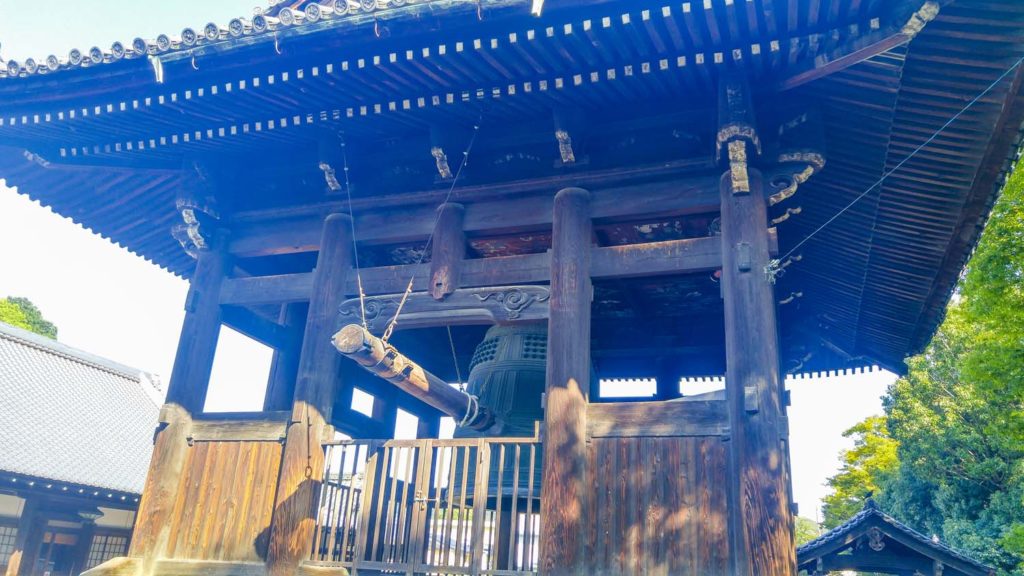
This prayer bell is the largest in Japan. It is 4.2 meters high and weighs a whopping 82 tonnes!
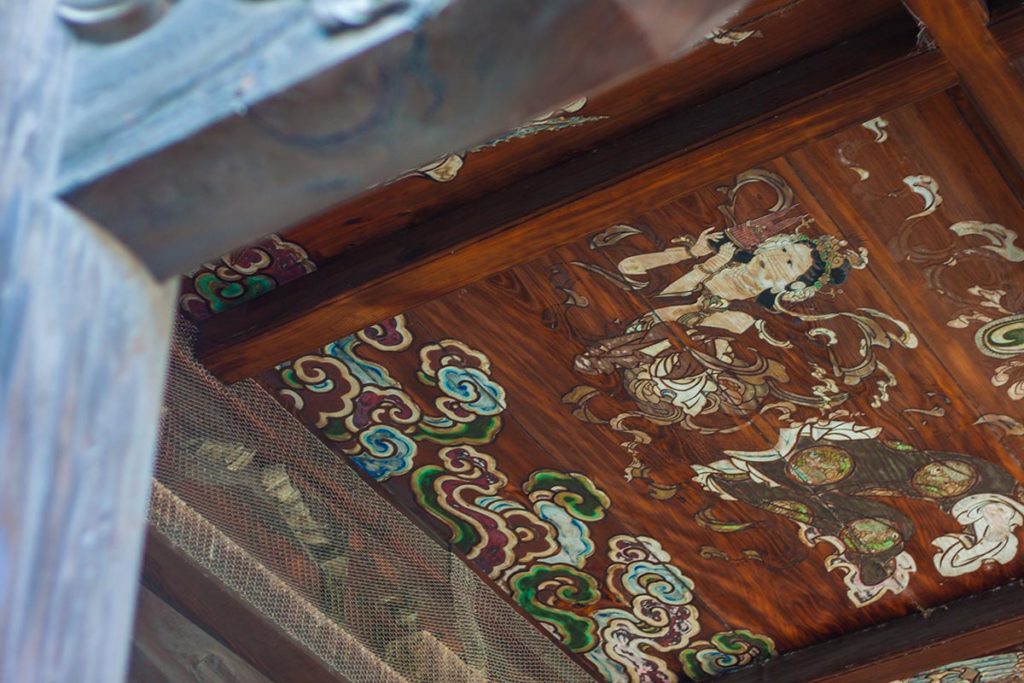
If you crane your head over the barrier, you can see restored engravings and paintings that decorate the ceiling of the bell’s roof.
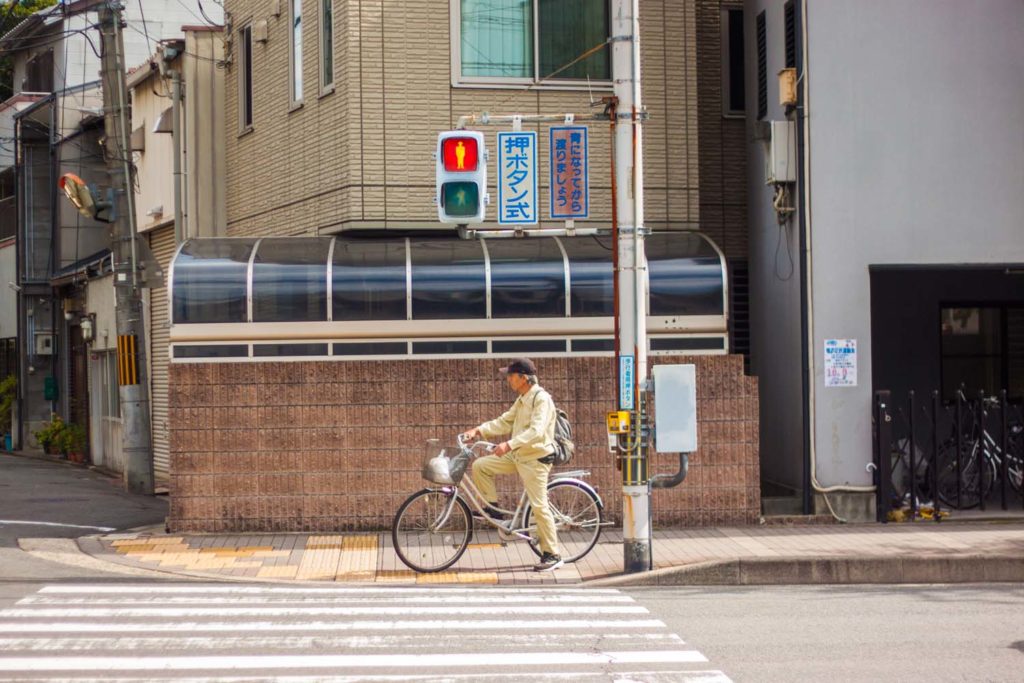
Not many people visit this temple, as it’s not one of the most notable. But as such, it was such a peaceful place to contemplate life and end our tour of the backstreets of Kyoto.
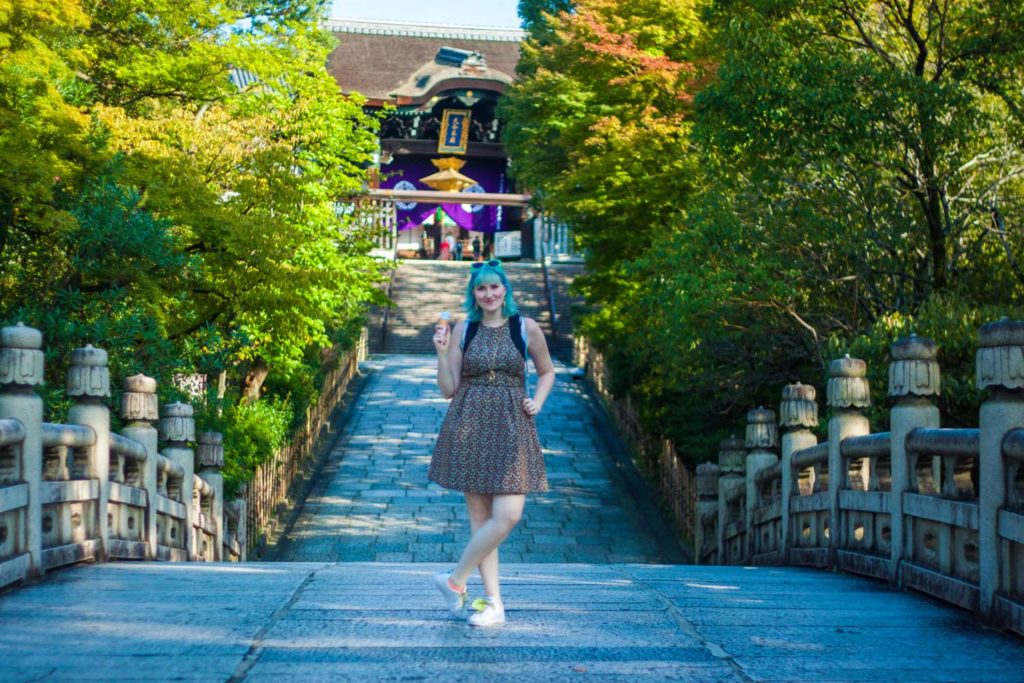
I hope you enjoyed this backstreets tour. Finding hidden treasures along the way is my favourite part of travel, so don’t hesitate the share your favourite unknown aspects of this incredible, historical city!
Happy Travel Adventurers!


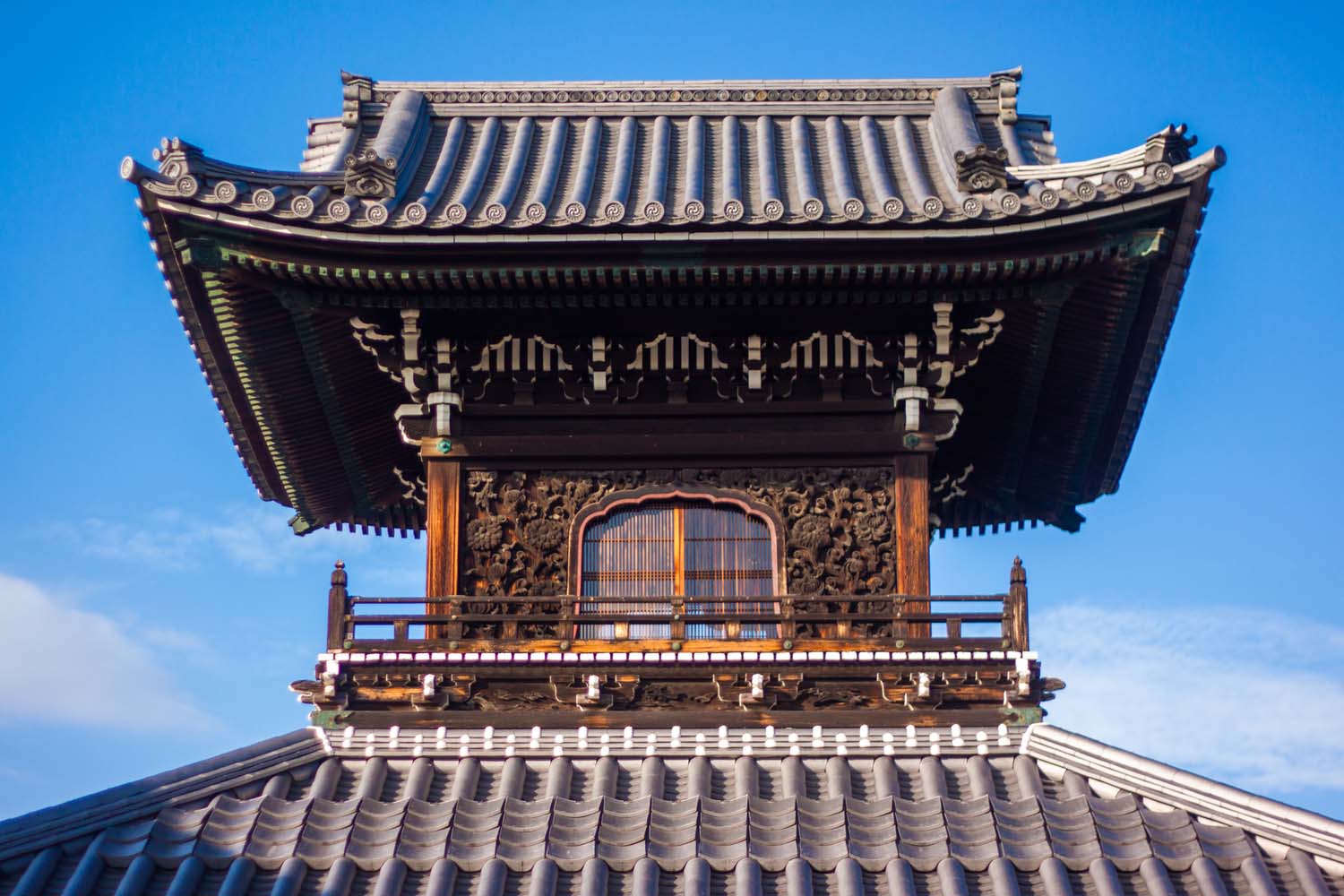


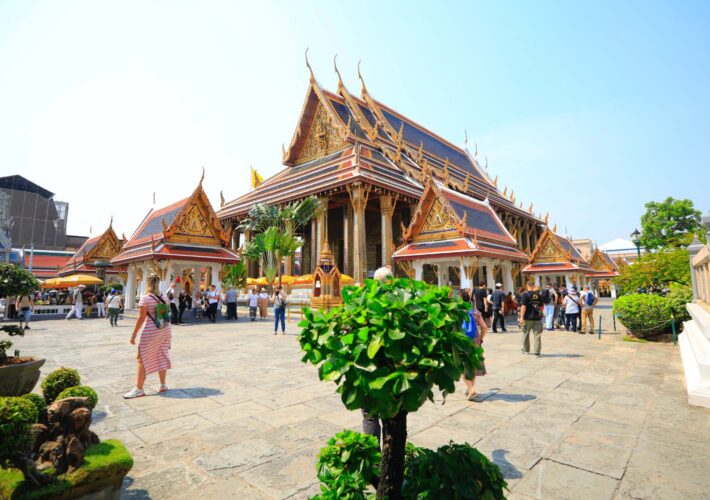
Leave a Comment